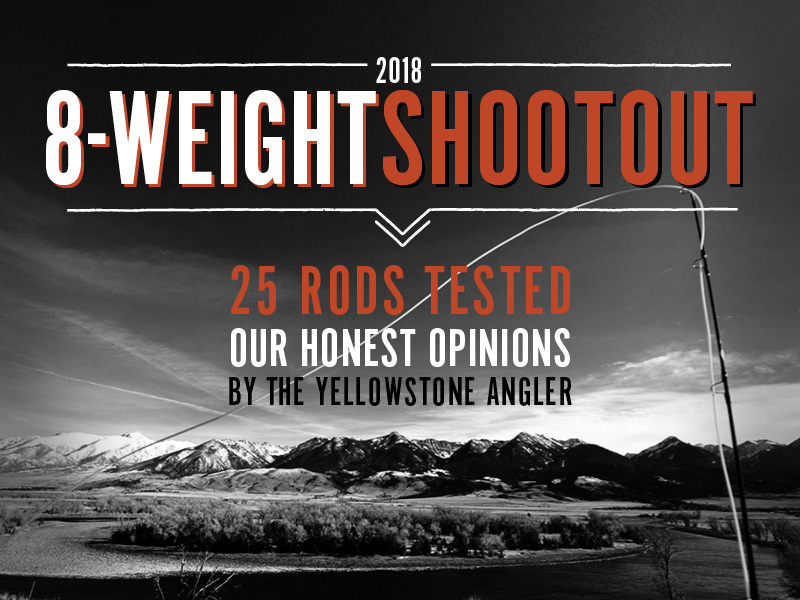
2018 8-Weight Fly Rod Shootout
by
George and James Anderson
With comments by the Yellowstone Angler Staff
Note* The final results and performance charts on this page are George’s figures. To read each staff memeber’s casting notes and performance finishing order, please click on their photo above.
With all the great new rods on the market since our 2016 8-weight Shootout, everyone at the Yellowstone Angler was excited about doing another 8-weight rod Shootout. Since most manufacturers released the rods in mid-July at the ICAST show, we have gotten our hands on all the new ones, and have done a lot of casting and fishing with them. We were anxious to see how the latest new rods would stack up against our top 2016 Shootout rods like the Scott Meridian and Loomis NRX.
The new crop of rods – particularly the Loomis Asquith, the Orvis Helios 3, and the Thomas & Thomas Exocett, all appeared to be capable of knocking off both the Meridian and NRX! Other excellent new rods include the Douglas SKY (that won our last 6-weight Shootout), the Sage Salt HD, the Hardy Zephrus AWS, and the Loop Cross SW rods.
How would inexpensive new rods like the Loop Q at $229, the Redington VICE at $199, and the Mystic Inception at $120 fare against our favorite inexpensive rods – the Fenwick Aetos at $189.95 and the TFO BVK at $279.95?
What about the new Sage Salt HD and how would it compare to the Sage X and Motive? We also had a revised version of the Douglas DXF that looked promising, and other new rods to test like the TFO Axiom II and the Redington CRUX and VICE.
As in the past, the only logical way to get the answers we were looking for was to collect these rods, then put the exact same reels, lines and leaders on them and do a Shootout. Herewith are the results of our 2018 8-weight Shootout.
This fall the weather was more cooperative than usual here in Montana, so we decided to do the Shootout here, rather than in Florida. During November, we found days when it was warm enough, and the wind wasn’t blowing hard (like it can here in Livingston), optimal conditions to see what each rod could do.
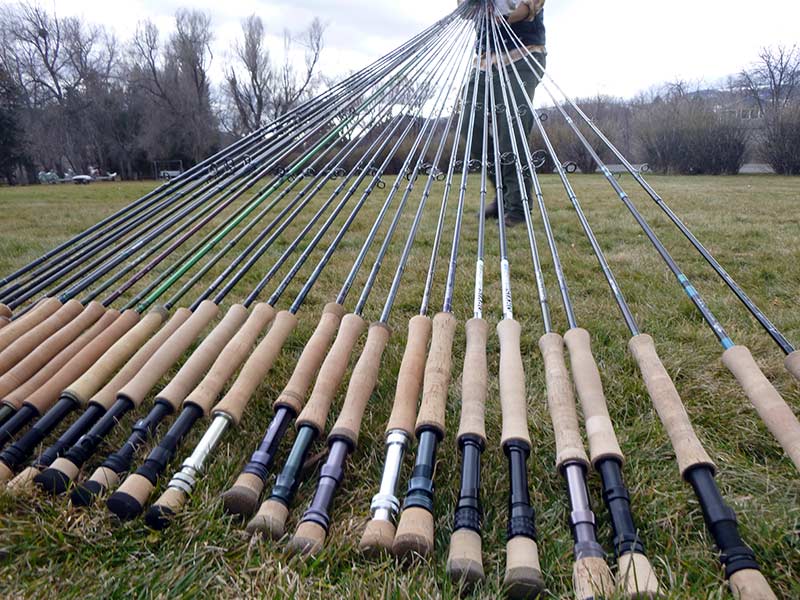
2018 8-Weight Shootout Results Summary
1. The new G. Loomis Asquith took first in our overall category, edging our 2016 winner by the tiniest of margins – 161.0 for the Asquith to 160.8 for the Scott Meridian!
2. The Asquith makes a convincing statement as the best performing rod in our Performance Scores with nearly a perfect score of 119.5 out of 120.0, besting the second place Scott Meridian’s score by 1.7 points.
3. The new Orvis Helios 3F, the G.Loomis NRX and the new T&T Exocett all finish in a close heat for 3rd place, in both the Overall and Performance scores.
4. The Orvis Recon, St. Croix Legend Elite, and Sage Motive are the best mid-priced rods in the $450-$500 class.
5. Under $400, the Douglas DXF and Hardy Shadow are neck and neck and terrific rods for the money.
6. The TFO BVK is our best performing inexpensive rod at $279.95 while the Fenwick Aetos is the best buy at just $189.95.

























Performance categories – right out to 100 feet
Again this year we have four distances at which we rate 8-weight rods – 35 feet, 60 feet, 80 feet and 100 feet. These distances are longer than those we rate rods in our other Shootouts, as we find that most people that employ 8-weight rods, use them in the salt – often for bonefish, snook and redfish, where the average casts are 35 to 60 feet. But sometimes much longer casts are needed – right out to 100 feet. For good anglers who have the ability to cast at extreme long range, the ability for a rod to perform well can often make the difference between catching fish or not. Let me relate this story from our 2016 Shootout again:
“A few years ago I was fishing in Cuba for bonefish in the Jardines de la Reina, where there are a lot of soft shallow flats. On a low incoming tide, we had several big fish tailing so far up on the flat that the water was just barely covering their backs. My guide Coki poled the Super Skiff up as close to the fish as he could on the muddy bottom, but we were stuck in 7 inches of water and still a long way from the fish. Getting out of the skiff to wade was not an option as the marl here was so soft that one step out of the skiff and you would sink in up to your crotch. The only way I was going to catch any of these fish was to make a cast close to 100 feet and get the fly and leader to turn over. Ninety feet wasn’t going to cut it. I grabbed my 9 foot #8 Loomis NRX, as this was the only rod in the boat that could get it done with its explosive power at long range. In the next fifteen minutes I caught two nice bonefish that I would have never gotten if I could not have launched that fly over 100 feet.”
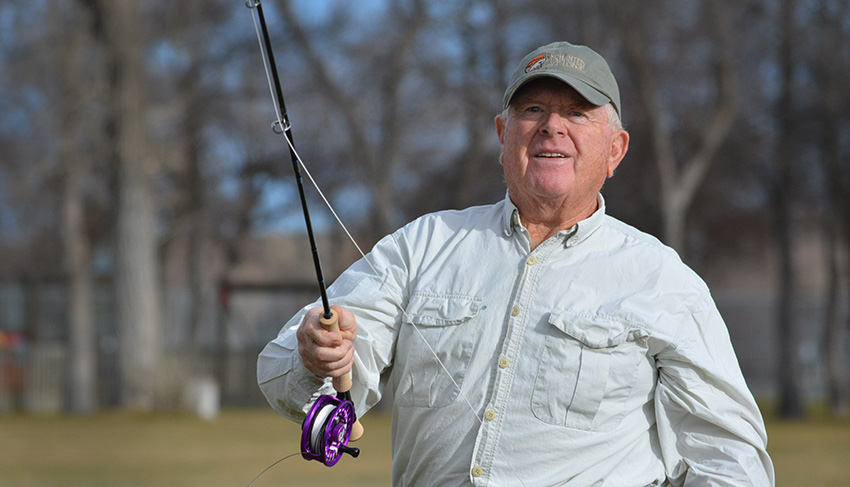
Picking the best 8-weight rod
The real meat of our shootouts is how a rod performs. For this reason we have again included a separate table of just the Performance Scores. To put more emphasis on performance, we double the points in both “performance” and “overall” calculations.
In our 8-weight shootouts we are looking for the best strong 8-weight rods that are ideal for powerful saltwater species like bonefish, redfish, snook, smaller stripers and even false albacore. But they must also be good rods in freshwater too, for catching big trout and other species worldwide. A good 8-weight rod can be used for bass, salmon and even steelhead. Of course for salmon and steelhead double handed and switch rods have pretty much taken over, especially on larger rivers.
A good saltwater 8-weight rod needs to be strong enough to fire 40-60 foot casts into a hard wind, and hit 80-100 feet with ease in calmer conditions. But it also needs to be very accurate, and delicate enough to present a fly to spooky tailing bones at 25-30 feet. It needs to have a securely locking reel seat that won’t work loose with larger, and heavier saltwater fly reels.
A full wells cork grip is our preferred style for power casting and playing good fish, and it helps to have larger guides that the inevitable line tangle will pass through when you are playing that bonefish of a lifetime.
To be the overall winner, a rod must be judged on many other things too, like price, craftsmanship, warranty, overall weight and swing weight. Swing weight, or the weight you feel in your hand with the rod held horizontally, is so important this is now part of our performance scores. Then to judge how fun a rod is to cast we added in categories like “Fun to fish/Got to have” as well as “Perfect 8 Performance,” which gauge what we feel are the very best all-around 8-Weight rods.
Fly rods get better and better every year. Now, only subtle differences separate most of the rods in our Shootout. If you buy any one of the top dozen rods in this shootout, we are confident that you will be delighted.
Keep in mind that what you will read here are only our opinions. I’m sorry if we offend some people or manufacturers. We are just trying to call it like we see it, in an unbiased manner. We stand by our methodology however, and by far most of the anglers that take the time to give us their feedback on these Shootouts agree with our findings.
As in the past, you will be amazed at how well some of the inexpensive rods do compared to rods that cost hundreds of dollars more. We’ll help you find just the right rod in your price range by giving you our picks for the best mid-priced rod as well as the best inexpensive rod.
Why Trust Our Opinions?
After nearly 50 years in the fly fishing business as a guide, shop manager and shop owner, I’ve learned a lot about what it takes for a fly rod to perform well. I’ve helped many manufacturers like G. Loomis, Sage, Scott and Tom Morgan with their rod design process. For the past thirty years I’ve enjoyed fishing for bonefish, permit and tarpon throughout Florida, the Gulf coast and the Caribbean.
My son, Jamie is also a fanatical fly fisherman and a great caster. He has been a very important and integral part of our Shootouts and tackle comparisons over the years, as in addition to being a test caster and editor, he’s responsible for putting all of this on line and producing the accompanying photographs.
In addition to my comments in the main Shootout, you’ll want to read the comments from Jamie and our other Yellowstone Angler staff members, JG (Josh Green) and Logan Brown. These guys are also expert casters and very experienced anglers. Their choices sometimes differ from mine, but we are almost always in general agreement on the top 4-6 rods in the Shootout.
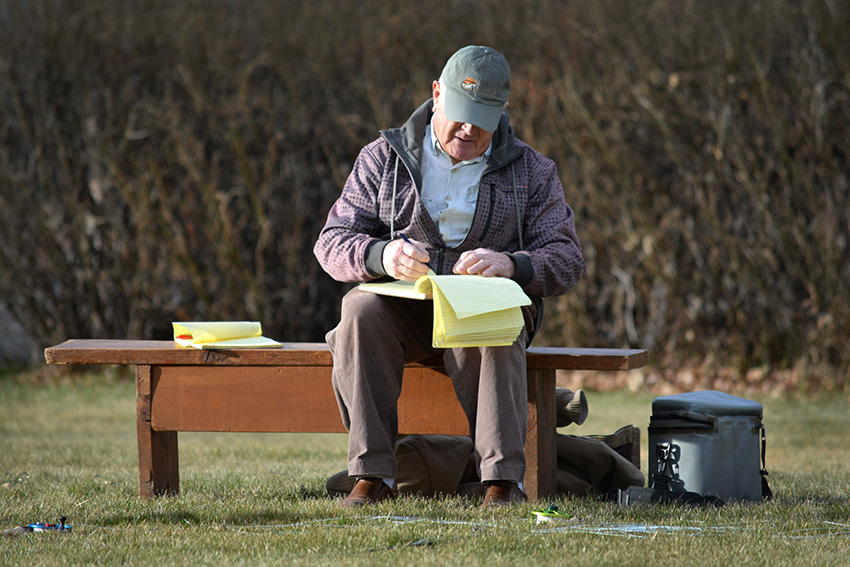
The best rods are not always the most expensive
As you’ll read again this year, there are some outstanding rods that have scored higher than rods that are two to three times as expensive. The best examples here are the Fenwick Aetos at $189.95 and the TFO BVK at $279.95. Saving $500 or more is nice too! You can take that money you saved and put it towards a nice saltwater reel and line.
If you want the best rod in performance, looks, and durability, plan on spending $800 or more. There is no question that the craftsmanship is better on the very best rods. And with a few exceptions, they perform better than the less expensive rods. Will they make you a better angler? Our answer to this is a definite yes. But are they $500- $800 better? You’ll have to make that decision. Part of your justification is the wow factor, as the best rods are often a status symbol. Are you comfortable showing up with a $189 rod on your next $6000 bonefish trip when all your buddies have the hottest $800-$1000 rods? (Or maybe that’s the whole point)…
Our advice is that if you can afford it, buy the best. You’ll never regret it.
Great Anglers Design the Best Rods
Over the past fifty years, it has become very apparent to me that the best rod designers are guys that are also great anglers. From their own fishing experiences, they know just what is needed for specific fish and the fishing conditions that anglers are likely to encounter. They can take a design and fine tune it to perfection, making a few tweaks and design changes along the way to end up with the perfect rod that is needed. A lot of people come to mind, but fellows like Steve Rajeff (G.Loomis), Howard Croston (Hardy), and Fred Contaoi (Douglas) are guys I’ve spent time fishing with on small streams, big rivers and in the salt. Other rod designers I know that are great anglers are Jerry Siem at Sage and Jim Bartschi at Scott. And of course Lefty Kreh has worked with TFO to give us the wonderful BVK rods.
Keeping it Apples to Apples –
An effort to eliminate the variables
As in all our prior Shootouts, we have strived to eliminate the variables by setting up the rods with the exact same reels, lines and leaders. By having all the rods set up identically, it makes it easy to take a few casts with one, lay it down on the grass, and immediately pick up another rod and do the same without having to take the time to strip all the line off the rod and load up another one. This way the four of us could be comparing two to three rods at once at our individual casting stations. Casting all these rods on a heads up basis is the only good way to determine the subtle differences among the rods and get a good feel for how they compare at the different distances. It was always good to have what we felt was the top rod in any price category right there on hand to make an immediate comparison.
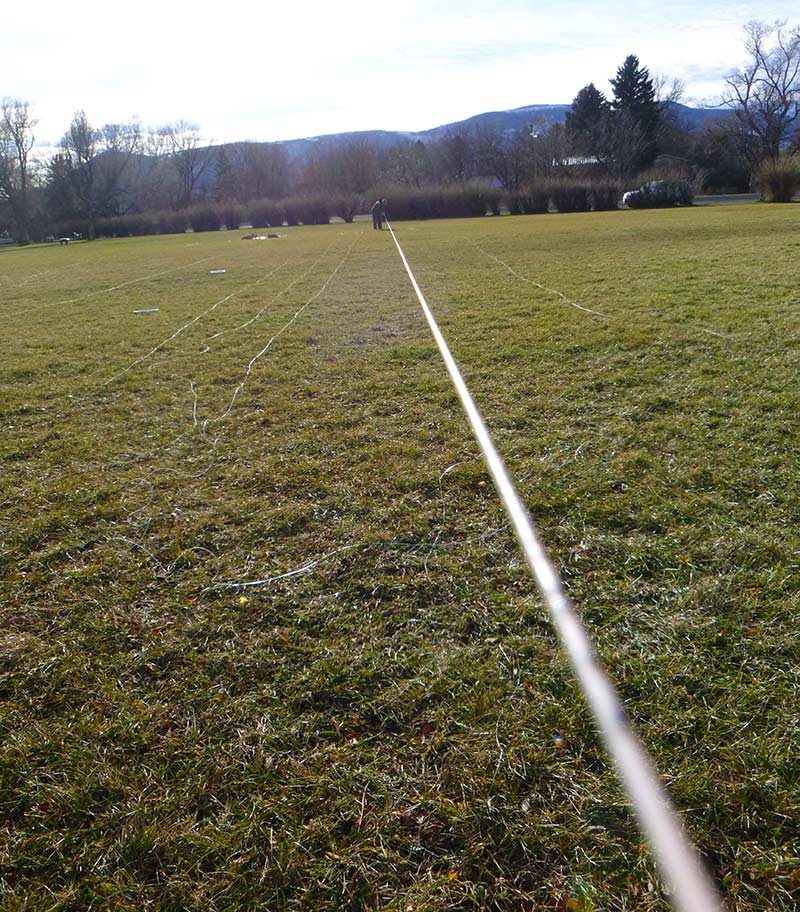
For this 8-weight Shootout, we again decided to use our favorite 8-weight reel – the Nautilus G-7/8. We had 10 identical Nautilus G-7/8 reels set up with our favorite bonefish line, the new Scientific Anglers Amplitude Bonefish Taper in WF-8-F. On the lines we used our own 12-foot-1X Yellowstone Angler hand tied bonefish leaders since they simply cast better and more accurately than any of the knotless leaders. And using a 12 foot leader really shows you how well these rods will turn over a long leader. Rather than use a fly, we used a fluorescent orange yarn indicator at the end of the tippet. This allowed us to judge the casting accuracy, even at the longest distances. We cut the yarn indicators large enough to provide plenty of wind resistance to make them nearly as hard to turn over well as an actual fly.
Setting Up the Casting Stations
If you have read our Shootouts in the past you can skip this part. For new readers however, we thought it would be good to explain how we set up our casting area.
We typically have at least four casters giving you their comments in our Shootout. We feel it is very important to have expert anglers and casters provide their comments since knowledge of rod design, flex patterns and components is so important.
For this Shootout we used one of the soccer fields in Livingston with plenty of room to set the casting line and fine-tune it, depending on wind direction.
We set up 4 individual casting “stations”, each with about 30 feet of elbowroom on either side. This allowed everyone to cast comfortably, and eliminated line tangles.
Each casting station consisted of 4 targets, (which were 12 inch round white paper plates nailed to the grass), the closest at 35 feet, the second at 60 feet, the third at 80 feet, and finally a target at 100 feet. We realize many anglers will rarely cast this far, however the 100-foot mark is important because it helps us judge the power of each fly rod. And as I explained earlier, there are instances when being able to cast 100 feet can help you catch a fish that would not be possible otherwise. More often than not, anglers are faced with a good amount of wind when flats fishing. The same rods that have enough power to hit 100 feet make it a lot easier to hit 60 feet when you are battling a 15-25 mph headwind.
We stake down a starting line with bright colored tape, so each caster knows to stay behind the line. We use a tape measure to get the precise casting distances at each station, and make them uniformly parallel.
Since we were casting in November in Montana, but using tropical bonefish lines, it was important to stretch each of the lines before casting them. Once we had the whole 100 feet stretched out, we would strip the lines into loose coils at our feet.
We know that anglers will be using a fly to fish, however we know from experience that using a half inch of glow bug yarn as an indicator at the end of the leader, comes close to duplicating the wind resistance of a typical bonefish fly with the hook cut off.
The important thing here is for each rod to have the exact same length bonefish leader and tippet, and the same amount of yarn used for the indicator.
Using a yarn indicator also allows us to power rods and develop high line speed, watching the kind of loops they deliver, without the possibility of breaking the tip with a lead-eye fly.
Reels: The Nautilus G-7/8 reel
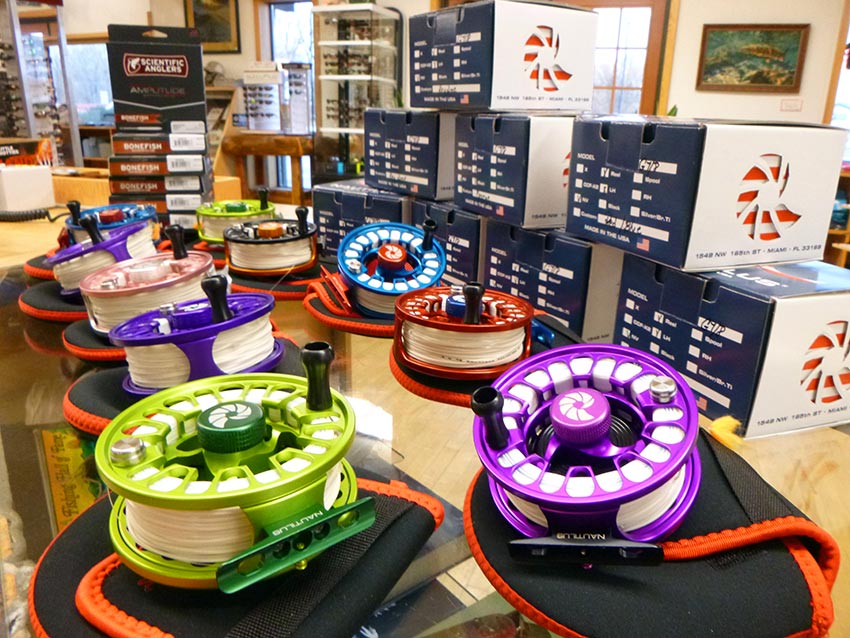
The Nautilus G-7/8 is our reel of choice on any 8-weight rod, especially when you need the ultimate in performance to handle sizzling fast bonefish runs or the bulldog like power of a big Louisiana redfish. Yes there are cheaper and more expensive reels, but you won’t find one that is better. The G-7/8 is just a size down from the G-8/9 Nautilus that won our 2014 8-weight Reel Shootout. These wonderful reels have a wide arbor spool, with a big handle that you can grip very easily. They are light in weight, yet have a totally sealed drag system that utilizes four sets of ball bearings and a carbon fiber disc drag that provides very smooth and strong resistance, with a wide amount of adjustment. The Nautilus reels also have a lower start up inertia than any of the reels we tested. The G-7/8 has the capacity for the S.A. WF-8-F Amplitude Bonefish line and 200 yd. of the Hatch 68 lb. backing. With 20 lb. micron backing you’ll have capacity for 170 yards, all without overloading the reel. Like the Tibor reels we’ve used in the past, the Nautilus reels are bulletproof and will provide a lifetime of enjoyable service.
Our pick for best WF-8-F Bonefish Fly Line:
Scientific Angler’s Amplitude Bonefish
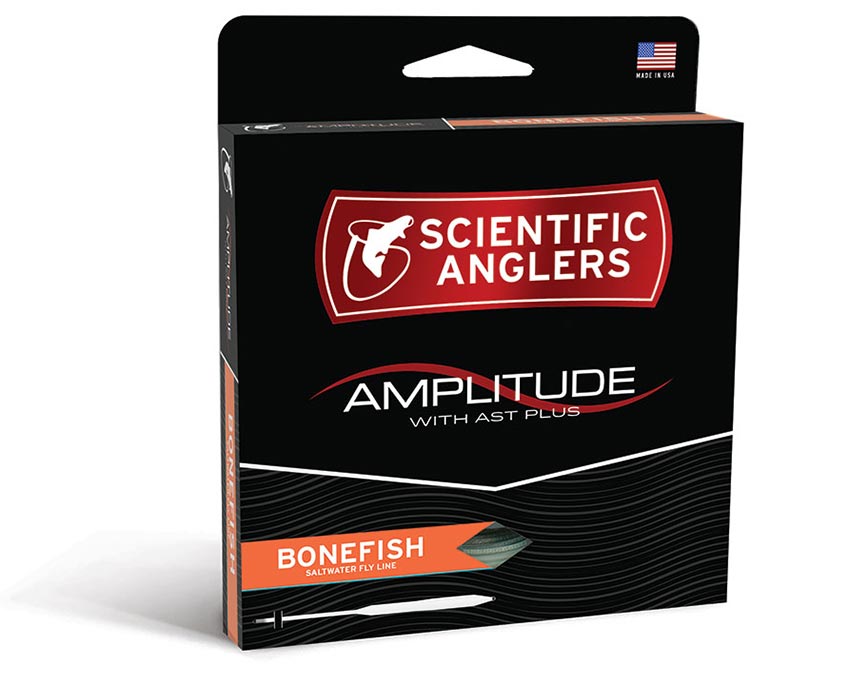
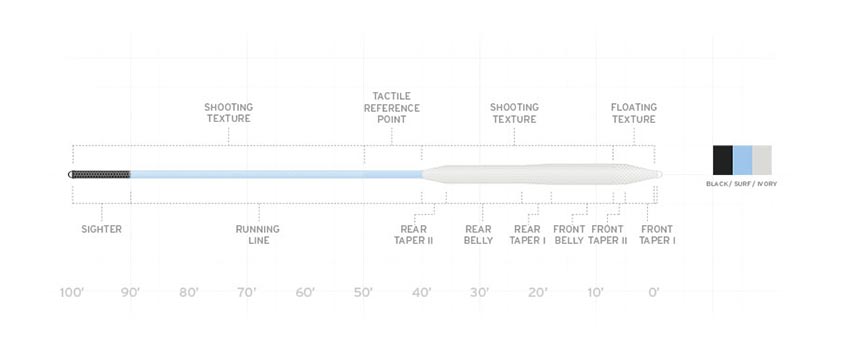
For this 8-Weight Shootout, we are trying to gauge how well each rod performs with an 8-weight line. However, we know that some of these rods would be better with a 9-weight line. If you are having problems with any of these rods loading well at short distances, don’t be afraid to go up to a 9 weight line or at least try one before settling in on which line to use. For most anglers though, we feel that an 8-weight line is the one to use. Rods that we feel might benefit from a #9 line are the Loop Cross SW-Fast, the Sage Salt HD, and the Redington Vice.
In the past we have used the standard SA Mastery Bonefish Taper, but their new Amplitude Bonefish taper is even better. This 100-foot line utilizes a 40-foot head (including tapers in a WF-8-F) and a 60-foot belly. The first few feet of the tip is textured for the ultimate in flotation, then it goes to a smooth line for the remainder of the belly. A light texture on the shooting line allows the line to shoot like crazy. This new line has the S.A. Tropi-Core technology – a stiff coating and stiff core, perfect for warmer climates. At the back end of this Amplitude line is a 10-foot section of black line, called a sighter. The idea is to show you where the start of the fly line is when you are playing a fish that has run well into your backing. This sighter makes it easy to see how much backing you have out as you are reeling it back onto the reel. Once I have the fly line back on the reel, then I feel comfortable putting a lot more pressure on the fish to land it. I think this “sighter” is handy, but if you would rather not have it on your line, it is easy to take off, as it is attached with loop-to-loop connections.
What surprised us was how well the Amplitude Bonefish cast compared to the previous Bonefish Taper, and how well it would shoot, even here in the colder Montana weather, once we stretched it out. So at the beginning of each casting session we would stretch out the full length of each line- stretching it perhaps 15 feet or more. We would then strip it into loose coils at our feet while casting the rods. Of course once we reeled up the lines on the reels we had to stretch them out again before more casting was done.
For cold-water applications you’ll want to switch over to a softer, colder water line like the SA MPX or the Amplitude MPX. Anglers fishing for stripers etc. in temperate climates often use an intermediate line like SA’s Sonar Titan. Throwing streamers for trout, our favorite sinking line is the new SA Sonar Sink Tip, type V that has a 14-foot sink tip in WF-8-F. The SA Sink 25 Cold gives you a 25-foot super fast sink tip. Their Intermediate/Sink 3/Sink 5 line gives you a line with a fast sink type 5 tip, a Sink 3 section behind this and then an intermediate running line.
LEADERS
12′ 1X (14.5 lb. Fluoro) Y.A. Hand tied Bonefish Leaders $7.95
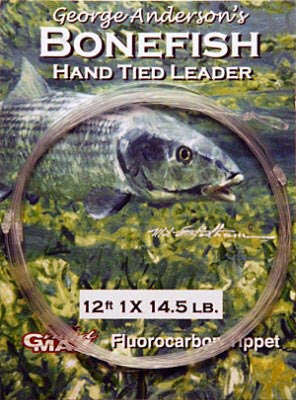
We have been tying our own bonefish and permit leaders for over twenty years, using Mason’s hard nylon for the butt and midsections, and then adding Seaguar Tatsu double structure fluorocarbon for the final two tippet sections. I designed these leaders with very stiff butt and midsections, and a short taper that allows them to turn over extremely well, even in a harsh wind. Our 12-foot bonefish leaders, with a 30-inch tippet, will turn over far better than any of the knotless tapered leaders on the market, making them perfect for our Shootout. These leaders are all hand tied, and hand tested by us here at the shop.
Rod Deflections
Our deflection charts have been so popular that we have included them again this year. These allow everyone to see the manner in which each rod bends, and more importantly, how that compares with the others. Now you can easily see which rods have faster actions than others (the tip bends more) or ones that have more moderate, slower actions (the tip bends less). To make the deflection chart, we place the rods at a 45-degree angle and then hang a weight of 6.2 oz. from the tiptop. Then we trace the outline of the rod in different color sharpies.
Keep in mind that fast action rods are not necessarily stiff rods (as many people assume). The tips on the faster action rods bend more, and if you look at the top rods, you will see that they tend to be faster action rods. We have found that this is the key to getting good accuracy, especially at closer distances. On the other hand, the best rods must have enough butt and mid-section power to throw longer distances with ease or bring a line screaming 10-pound bonefish to hand.
Click on the photo below for more deflection charts, including the best 8-weight rods, the best mid-priced 8-weight rods, the best inexpensive rods, and finally all 25 rods.
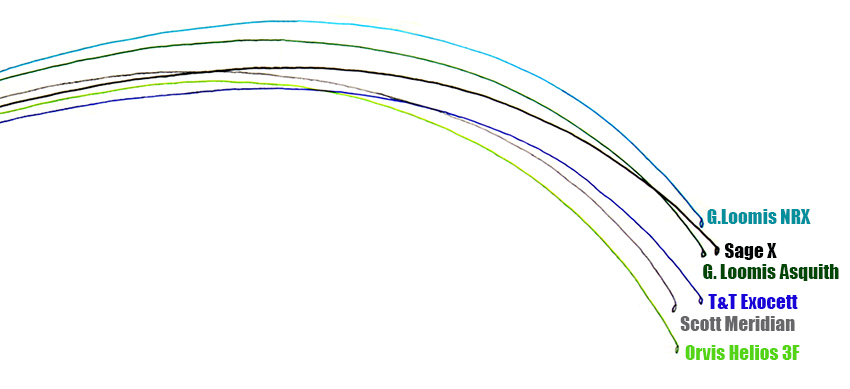
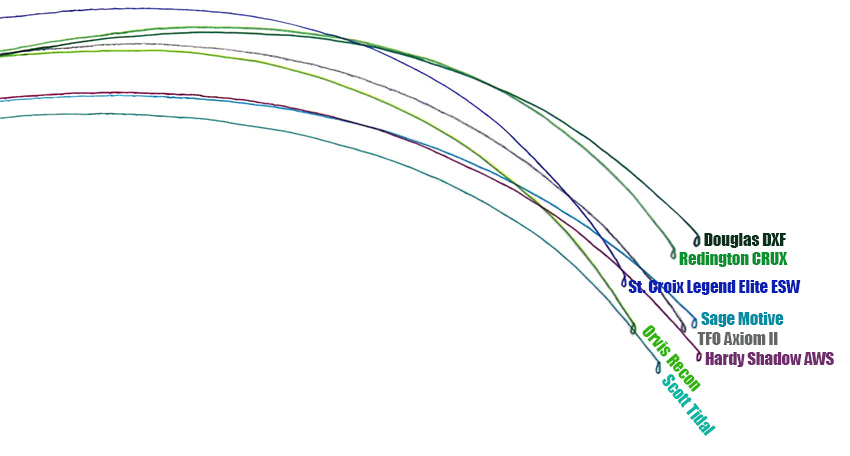
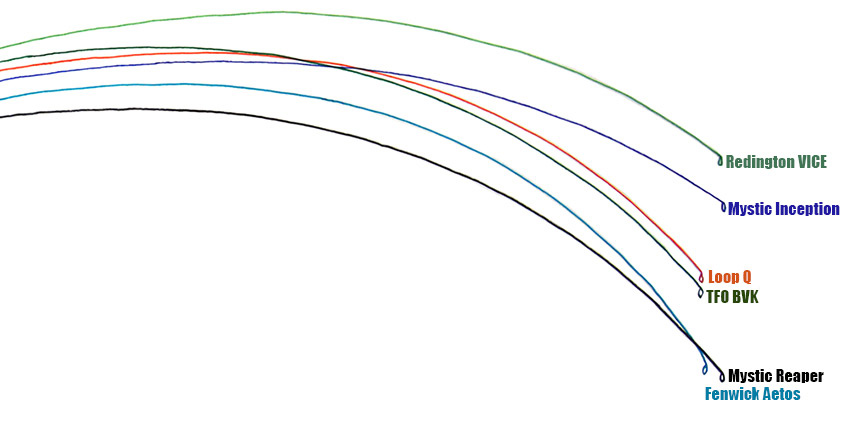
With over forty years of experience, I can usually get a pretty good idea of how a rod will perform, just flexing it in my hand. But the final analysis is always casting the rod and seeing what it will do when matched with the right reel and line.
We have found that the only good way to determine if one rod is better than the other, is to cast them head to head on the lawn, set up with the exact same reel, line and leader. Only then do subtle differences reveal themselves.
Explanation of the points categories
Price – 10 points available
This is easy – The least expensive rod gets the highest points. Price is certainly a big factor in your decision to buy a rod. But keep in mind that the higher priced rods are usually worth it in the long run, even if you have to take some time to save up the money to buy the one you really want.
Experience has shown us that novices entering the sport of fly-fishing often opt for less expensive rods, hoping to economize. But quickly they come to realize that the ease of casting, the tight loops and control the higher priced rods provide, allow them to develop their casting skills much more rapidly. The result: the cheaper outfit is mothballed, sold for a loss on e-bay, or handed down to a relative. Don’t make this common beginner’s mistake.
With the inexpensive warranties most manufacturers offer, this new rod is one that will last you for many years and this makes it easier to justify buying a more expensive rod.
My advice has always been that if you can afford it, buy the best. You’ll never regret it.
Craftsmanship – 10 points available
We are pleased to tell you that craftsmanship has improved steadily over the past ten years. Even the inexpensive rods made in Korea have surprisingly good craftsmanship. The best Korean rods rival what is produced here in the US. Are they better? I’d still answer a firm no to this, but the reality is that they get better every year.
Craftsmanship varies to some degree from rod to rod. We look at lots of things to determine this. What kind of guides are being used and how are they wrapped and finished? To our way of thinking, the very best guides for saltwater 8-weight rods are the nickel/titanium unbreakable snake guides that are fairly large in diameter to allow line tangles to pass through. But these are expensive guides and you won’t see them on any cheap rods. Look at the coatings on the rod wraps. The best are done with multiple coats of finish, rather than one thick coat. Check out the Thomas and Thomas rods or Scott rods if you want to see wraps and finish that are just about perfect. Too many manufacturers try to get by with a one-coat epoxy that is too heavy, adding weight to the rod. The quality of the cork in the handle is a big factor too. The best cork handles are laid up with individually selected, near perfect cork rings, then sanded down to size. Some of the best new rods from Loomis, Scott, Orvis and T&T use a stack of much thinner rings than we have seen in the past. These thin rings produce a finished cork grip with almost no defects that will hold up under the hardest usage.
On most inexpensive rods, manufacturers are using cheap pre-shaped grips that need a lot of filler, which doesn’t look very good. Reel seats should have good solid locking systems to hold larger saltwater reels without working loose. And the locking rings need to be easy to grip and tighten. Many of our tested brands get a 9 for Craftsmanship, but there only three perfect 10’s – the Loomis Asquith, the Scott Meridian and the T&T Exocett.
Warranty – 10 points available
Today every manufacturer now has some kind of limited “Lifetime warranty”. Well, Orvis is only 25 years. However, nearly all manufacturers are charging a “handling fee” of $25-$100 to repair or replace your broken rod. But remember it is going to also cost you $15 or more to ship the rod in for repair or have your dealer do it for you. We looked at all the warranty policies in detail as some have changed slightly and we have awarded scores emphasizing the lowest repair charges and the quickest repair turn around. To get a 10, repair charges had to be $35 or less with a quick turn around time of less than two weeks. As you’ll see, most rate a 9, which means that it costs $40-$60 for the repair or replacement. If your favorite rod breaks in the middle of the summer and you don’t get it back for a month and a half, you are going to be very angry! The Loomis NRX gets a perfect score of 10 for their excellent Expeditor repair program which charges you $100 but you get a brand new rod, not a repaired one, in just a few days. This same Expeditor service applies to the Asquith but the fee is $275 for 2nd day air. For this reason we downgraded the Asquith to a 7. Loomis does send you a Fed Ex or UPS call tag so that you don’t have to spend any money to send the broken rod back.
For broken rods that are not registered to the original owners, most companies are going to charge you $150 or more to get these repaired. Below the final results charts we give you the exact repair charges for each manufacturer.
Fun to Fish / Got to Have – 10 points available
We borrowed this category years ago from the Car and Driver’s automobile shootouts. If the rod looks like a million bucks and casts like it too, most fly fishermen will lust for it. For many, it might be seen as a status symbol. For others, they see how this rod performs in their guide’s hands, and think that it is going to make them great anglers too and at least take them to the next level. Surprisingly enough, they are often right. Great rods don’t make great casters, but they can sure help an average caster advance a lot faster. Don’t let the price slow you down. You’ll find some ingenious way to sneak it into your stash without the little lady (or husband) finding out.
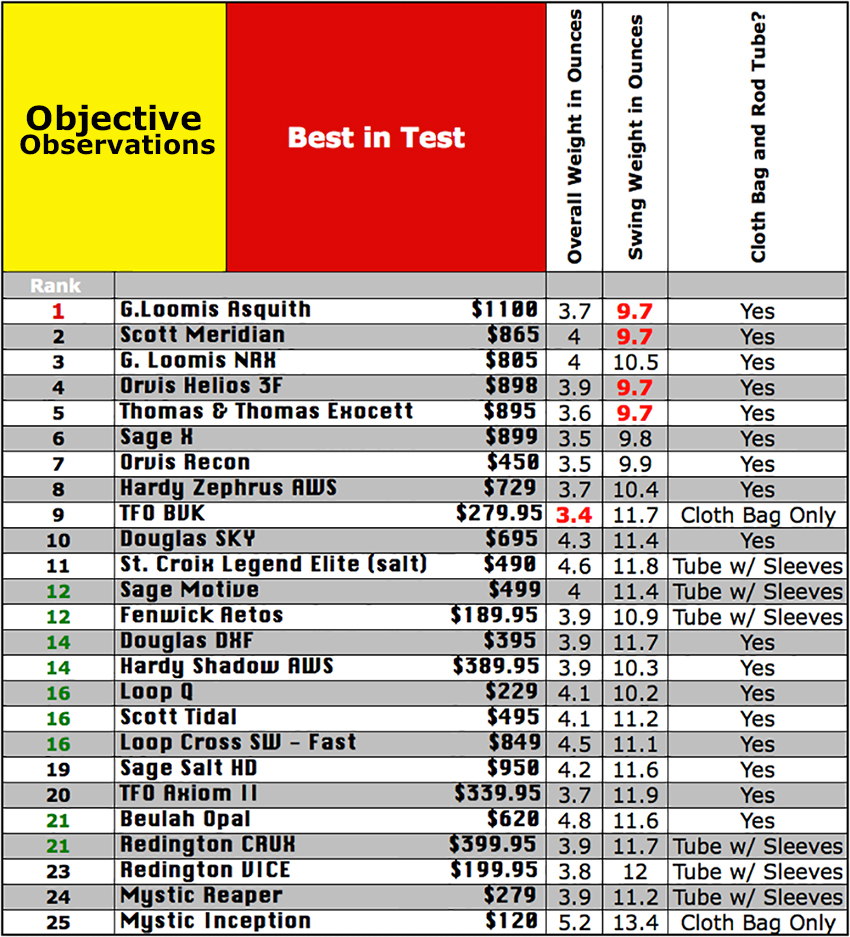
Overall Weight – 10 points available
Manufacturers usually list the weight of their rods on their websites but we like to confirm this with our own “Official” Brecknell US postage scale. We round the weight to .1 of an ounce to make it easier to compare one rod with another. You can see these totals in the above on Objective Observations. Overall weight is one factor, but the swing weight is far more important.
Double points awarded for performance categories
How a rod performs is the real meat of our Shootouts, so we double the points for these categories. Again this year, for the 8-weight rods, we rated the performance at four distances – 35 feet, 60 feet, 80 feet and 100 feet. The very best 8-weight rods are high performance rods that will perform well at all these distances.
Swing Weight – 20 points available
You know all about this term if you play golf. It is the relationship of the club head to the shaft when you wiggle the club. We have experiment with this over several Shootouts and prefer the tried and true approach. Using our postal scale, that produces meaningful and believable results. The swing weight of the rod is the weight you feel out ahead of your hand, when you hold the rod in a horizontal position. A little wiggle helps you to feel this. Rods with a light swing weight are pleasant and effortless to cast. Ones with a heavy swing weight feel like a club in your hand and they are not going to be pleasant to cast all day.
Here is the way we compute the swing weight:
Measuring this on a fly rod is not quite as easy though. First, we zero out the scale with a small foam pellet in the center of the scale, which we will use for a fulcrum on which we will rest the grip of the rod. Next, holding the rod in a horizontal position, we position the grip over the foam pellet so that the pellet is centered under the exact spot where you will most likely hold the rod with your hand. For most full wells grips this will be at the midpoint in the swell, in the center of the grip. However on some rods like the Scott Meridian, where the swell is slightly forward of dead center, we move the fulcrum to that point. The idea here is measure the swing weight at the middle of where the palm of your hand is likely to sit on the grip. Once the grip of the rod is placed precisely on the foam pellet, with the rod in a horizontal position, we apply finger pressure, (usually by pressing down with a finger nail to the very end of the fighting butt), and read the weight we are getting on the scale. It often takes a little time for the rod to “settle down” from all this movement so we do this procedure 4-6 times and then take the average weight we are getting from the scale.
This is a test that anyone can duplicate. Just keep in mind that all these measurements must be made the same day with the same room temperature. We’ve found that fluctuating temperature and humidity from one day to the next can make a difference of .2-.3 oz.
In past shootouts we tried measuring swing weight in other ways, including calculations for the Moment of Inertia, taking the weight all 4 sections individually and then plugging these figures into an equation. But these methods and calculations proved to be incorrect from what we were actually experiencing in our hand – so we now employee the method explained above. No matter what method you use to determine swing weight, it is important to achieve a consistent and believable result that you can use to gauge one rod against another.
Performance at 35 feet – 20 points available
We stretch this close distance from 25 to 35 feet for the 8-weight rods. The best rods need to be able to cast very accurately and have the ability to make a delicate presentation that won’t spook wary fish. The top scoring rods are easy to cast off the tip of the rod with very little effort. At short distances, casting accuracy is the key to catching fish and the number one factor used in evaluating these rods. Some rods, especially the ones with softer tips, will give an angler much more feel and the ability to consistently put the fly just where you want it, and do it delicately. Bonefish can be very spooky in slick water when there is little wind, and I’m often trying to sneak in at very close range to tailing fish, even down on my knees casting to the fish that may be only 15-20 feet away. In situations like this, keeping the rod low to the water while you are casting will help. Both the Scott Meridian and the Orvis Helios 3F took the top scores here.
Performance at 60 feet – 20 points available
Here is the range that I consider the most important of all for 8-weight rods. The rods that score well in this category, with scores of 19 or above, can really drill them in there, even in a hard breeze. With the best rods I was consistently hitting within 24 inches of the dead center of our paper plates. At this distance you need the rod to have the power to rip a good back cast and fire it in there on the forward stroke without much of a double haul and not shooting any line. Rods with a wimpy butt and mid-section need not apply. The rods that did the best job of zinging them in there time after time at mid-distance were the Asquith and Helios 3F. The Scott Meridian was a very close 3rd.
Performance at 80 feet – 20 points available
Any good 8-weight rod needs to be able to hit 80 feet easily. The most outstanding rods at 80 feet were the Asquith and NRX. Both tracked very well and had lots of power to get the job done. If you look at all the rods that scored 19.5 or better here, you won’t go wrong with any of them. There are not many times you are casting at these distances for bonefish or any species in either fresh or saltwater, but the best rods do so easily and consistently.
Performance at 100 feet – 20 points available
As I mentioned at the beginning of our Shootout, again this year we felt a need to rate the 8-weight rods at 100 feet. Some rods that perform well at shorter distances just run out of gas at extreme long range or when you have to drill a bonefish fly fifty feet into a 25 mph headwind. Here’s the category that separates the men from the boys – the contenders from the pretenders. Good casters that can double haul well can hit 100 feet with a lot of these rods. The Asquith wins this one hands down with the NRX a close 2nd.
“Perfect 8 Performance” – 20 points available
As in the past, we felt that a separate category was needed to reward the very best 8-weight rods for their overall superiority – as tested with 8-weight lines. These are the rods that you pick up, and make just one cast and you know they are something special. They give you the confidence to put the fly where you want it at any distance. Rods that are only good at close to medium distances are not going to win. Other rods that are great out long but not quite so good in close are not going to win this one, either. We’re looking for the very best rod at all distances with an 8-weight line. As you’ll see only four rods scored higher than 19 points – The Loomis Asquith, followed by the Scott Meridian, the Loomis NRX, and the Orvis Helios 3F. These rods are the best of the best, and all are assembled if not completely made here in the USA.
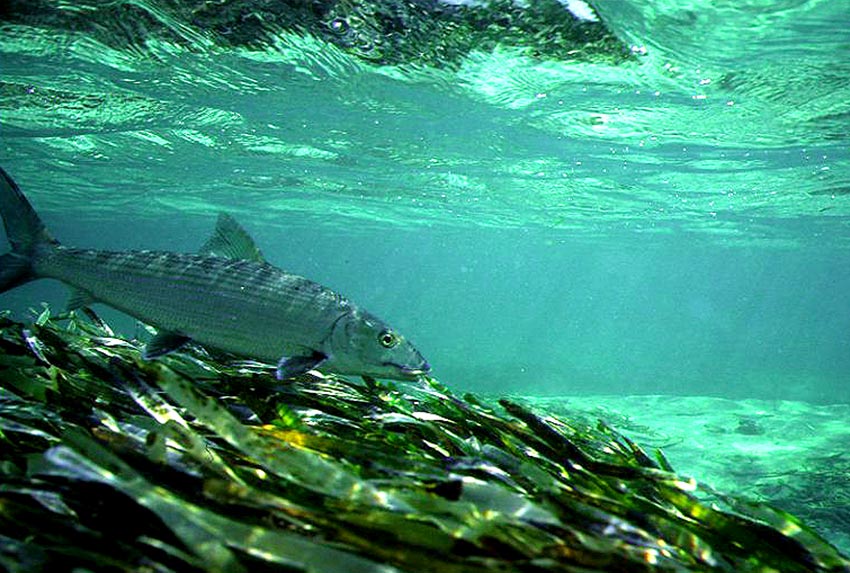
Warranties Explained
Here is a short recap of each manufacturer’s current policy, their latest fees and what we have experienced for repair time required. Remember that it will cost you an additional $15 or more to send your rod in unless you are using the Loomis Expeditor program.
Beulah – Original owner lifetime warranty for defects. Must be registered within 30 days. Breakage from misuse or negligence will be repaired at reasonable cost. $50 handling fee. Usually takes 2 weeks.
Douglas – Lifetime warranty. $35 handling fee. Rods are repaired, not replaced. Usually takes one to two weeks.
Fenwick- Lifetime warranty. $25 handling fee. Broken sections are replaced. Sometimes the whole rod is replaced. Usual time 2 weeks.
Hardy – Lifetime warranty to original owner. $35 handling fee plus $75 for each broken section – a normal total of $110. Rods are repaired. Shipping is from their US warehouse, usually about 10 -14 days.
G. Loomis – Lifetime warranty to original owner. You send in rod and their warranty dept. examines it. If rod is broken because of a defect, or while fishing, replacement is free. No handling fee. If from neglect or any other cause, you must use the Expeditor service, which charges your credit card $100 but you get a brand new rod in 3-4 days. The Expeditor service fee for the Asquith rods is $250.00 for ground or $275 for 2-day air.
Loop – Lifetime warranty to original owner. $60 handling fee. Rods are repaired or sections replaced. Same day or next day shipping if they have the parts in stock, if not, usually takes 2 weeks.
Mystic – Lifetime warranty to original owner. $50 handing fee. Rods are replaced. Usually takes 1-2 weeks.
Orvis – 25 year warranty to original owner. $60 handling fee. Rod is repaired, not replaced. Usually takes 2-4 weeks.
Redington – Lifetime warranty to original owner. $75 handling fee. Rods are replaced. Usually takes 2-4 weeks.
Sage – Lifetime warranty to original owner. $25 handling fee on current rods. $75 on recent rods within 10 years, $125 on Classic older rods. Rods are repaired, not replaced. Usually takes 4-6 weeks. Click here for specific details.
Scott – Lifetime warranty to original owner, $50 handling fee. Rods are repaired, not replaced. Usually takes 2-4 weeks.
St. Croix – Lifetime warranty to original owner, $85 handling fee. Rods are repaired, not replaced. Usually takes 2-4 weeks.
Temple Fork Outfitters (TFO) – Lifetime warranty to original owner. $35 handling fee. Rods are either replaced with a new rod or the broken section is replaced. Usually takes 1-2 weeks.
Thomas and Thomas – $55 repair charges for the original owner, includes shipping. Non-original owner $150 per section. You must register the new rod within 30 days.
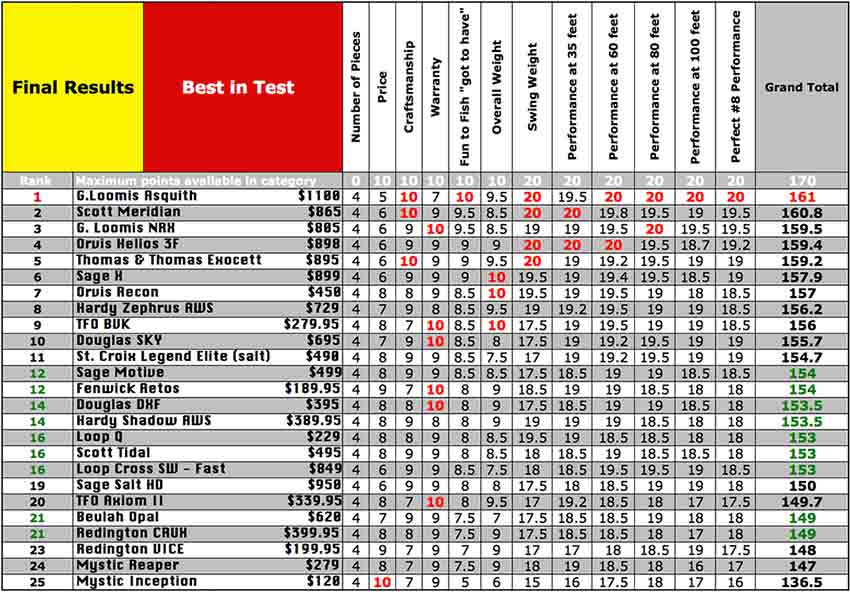
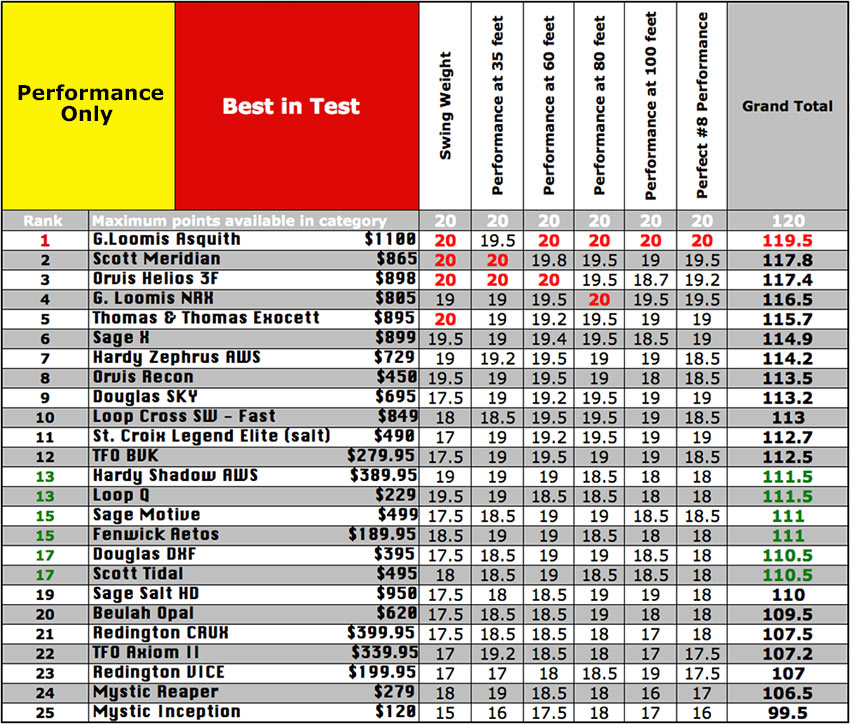
#1. G. Loomis Asquith 9 foot #8 $1100.00
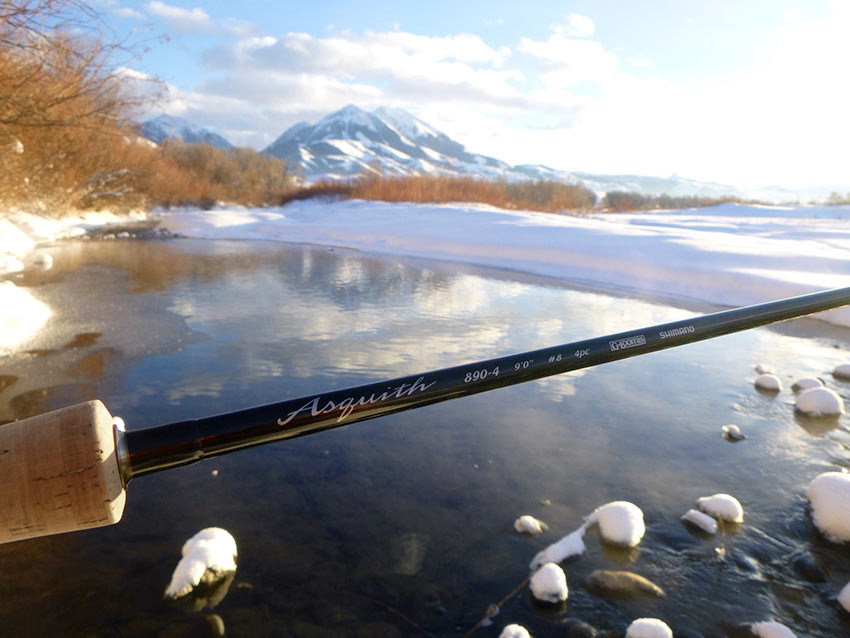

I got my first look at the new Loomis Asquith at the ICAST show in Orlando. After I made a few casts, I was amazed and impressed. I turned to Capt. Skip Zink, one of the testers in our last 8-weight Shootout, and said, “I think this new Asquith will be tough to beat in our next 8-weight Shootout!” How true this proved to be.
The Asquith is a marvelous rod and came close to running the table in our Performance Only scores, missing out by only a half point at 35 feet. In the final results it lost a lot of points in both the price and warranty categories but still managed to barely edge out our last 8-weight winner – the Scott Meridian.
After pleading with Loomis to let me try fishing one of the two ICAST show rods on an upcoming Atlantic Salmon trip, they gave me an Asquith to use so that I could give them some feedback. (The production rods didn’t reach retailers until nearly January of 2017). I put the Asquith through its paces that August, fishing for Atlantic salmon in Labrador. Then in September I gave it some hard use in Alaska, catching ten-pound rainbows. Then later in the winter I took it with me to Argentina, and had it bent over double landing Jurassic Lake rainbows up to 17 lbs. And finally this Spring I put it to use on big snook and redfish on Florida’s Gulf coast. Despite all the abuse I was able to dish out, the Asquith was an absolute joy to use and performed flawlessly.
This rod has an incredible amount of power combined with a very low swing weight. I’ve never cast a rod that tracks as well or forms such tight loops with so little effort. Fishing for Atlantic salmon on the Hunt river in Labrador, we were fishing large dry flies – #6 bombers, and I often had to throw them close to 100 feet and then get a good drift. I don’t think I could have ever done this with a rod other than the Asquith.
The Asquith’s enormous butt and mid-section power made it easy to manhandle 8-17 lb. rainbows in both Alaska and at Jurassic Lake. It often left me shaking my head. This is one amazing rod! I would have broken most other rods with the kind of bend I was putting in the Asquith. It is still hard for me to believe that this rod didn’t break, but the Asquith is as perfect today as when it was new.
Shimano will tell you that the secret to building such an incredible rod is the new Loomis/Shimano Spiral-X technology. Steve Rajeff fine-tunes all the Asquith designs, and then Shimano builds the blanks in Japan. The finished blanks are shipped to the G. Loomis factory in Woodland Washington, where the rods are completed.
The Spiral-X technology is far different from the way conventional graphite rods are built. It is a complex three-step process. Shimano has developed a special graphite tape, called infinity tape, which is wrapped on the mandrel on a 45-degree axis. Next, a layer of “muscle carbon” is wrapped on in a conventional manner. The final step is another wrap of the infinity tape, but at an opposing 90-degree angle to the first, so that the infinity tape forms an “X” pattern.
The beauty of this process is that it uses 15-20% less graphite to get the exact same strength as the NRX, which we know from experience is stronger than any other rods we’ve used. The other benefits of Spiral-X are that it reduces any twist in the blanks, and more importantly, it reduces ovalization as the rod bends. This gives an angler more feel combined with an enormous amount of reserve power. Bottom line, in use this rod delivers.
The Asquith is a fast action rod, but with a soft enough tip to give great feel and excellent accuracy at all distances. As I mentioned before, I’ve never cast a rod that tracks as perfectly as the Asquith. Right out to 80 feet I had the confidence that I could put the fly right where I wanted it almost every time. This is also a nice light rod in my hand, making it absolute joy to cast all day.
The Asquith tied three other rods with the lightest swing weight we measured. At short distance, only the Scott Meridian and the Orvis Helios 3F performed slightly better, giving me a little more feel but no better accuracy. From 50 feet on out to 100, nothing in our Shootout could best the Asquith. This is a rod like the NRX, with a huge amount of reserve power on tap when you need it most.
The only drawbacks are: 1. The price – at $1100.00 this is the first production rod to break the $1000 barrier. 2. If you break this rod it will cost you $250-$275 to replace it since the blanks are more expensive to produce. It costs more to repair a Ferrari than a Ford. But in my own experience this is an extremely tough rod and I seriously doubt that anyone is going to break an Asquith while fishing. A car door or a bad fall might do it. The one bright side of the Expeditor policy – you call Loomis, they charge your credit card and send you a brand new rod that you receive in a few days! And they also give you a FedEx call tag so that you can send the broken rod back for free.
The Asquith is a handsome rod, especially in the sunlight when the dark green finish just sparkles. Complementary dark green wraps are used and finished beautifully. Loomis uses two of the new titanium SiC stripping guides that are smaller than what Scott and Orvis use. They seemed to allow the line to shoot as well if not better, but might not allow tangles to pass as easily. Loomis uses the finest flexible nickel/titanium snake guides that we love, along with an oversize tip top. The cork handle is a Rajeff full wells design, slightly larger at the front where you grip it than behind the swell. The shape of the cork handle is similar to the CrossCurrent GLX rods, which taper down below the swell – a feature we like very much, especially when casting at long distances. Steve’s idea is to get your pinky and ring finger closer to your palm, which is not only a more comfortable grip, but also a more powerful one.
A series of thin cork rings is used to produce the finest quality handle you can put on a rod. The double uplocking aluminum reel seat uses a very lightweight but highly impact resistant, dark green CI4+ insert. I loved the easy to grip rings that made it simple to lock down a heavier saltwater reel. A short extension butt is used.
George’s casting notes:
Performance at 35 feet: 19.5 points out of 20
Superb accuracy, but the Meridian and Helios 3F had more feel with an equally light swing weight.
Performance at 60 feet: 20 points out of 20
Fantastic tracking ability produced very tight loops and superb accuracy. Nothing tracks better than this rod, nor is more accurate.
Performance at 80 feet: 20 points out of 20
Just a cannon at the longer distances. Only the NRX could match the Asquith at 80 feet. Amazing accuracy too. This rod is a real delight to cast long.
Performance at 100 feet: 20 points out of 20
Lean on this rod and you’ll be amazed at the explosive power on tap. Nothing can touch it, not even the NRX.
#2. Scott Meridian 9 foot #8 $865.00
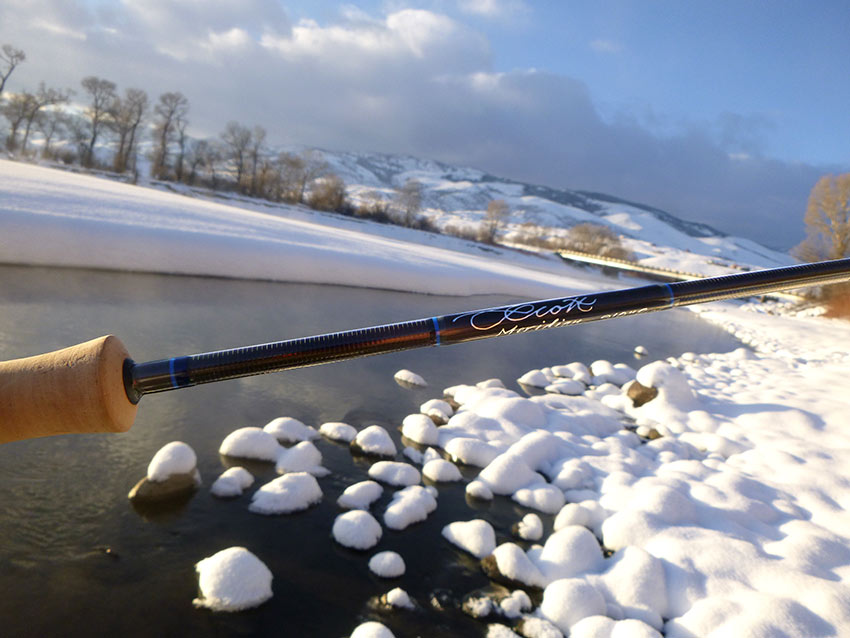

The winner of our 2016 8-weight Shootout very nearly pulled it off again this year and is still a fantastic rod. Jim Bartschi at Scott gave us a rod that combined a very light swing weight with great power and feel. One of the best things about the Meridian is the softer tip, which gives it wonderful feel and control at the shorter distances. But this rod has plenty of beans to cast long too. Only at the 100 foot mark did I feel it was not quite as good as the Asquith and NRX. The Meridian is especially sweet at the short to medium distances where anglers are fishing much of the time. At 35 feet the combination of great feel and accuracy was matched only by the Orvis Helios 3F.
This rod forms nice tight loops effortlessly, and its light swing weight makes it is a joy to fish all day long. This is one of the four rods that tied for the lightest swing weight in our Shootout.
The Meridian is a handsome rod with some of the finest craftsmanship we’ve seen. Scott uses absolutely the best components on this rod. I especially like the handle shape, putting the swell slightly ahead of the middle of the grip. Scott uses a stack of thin cork rings to give us the ultimate in a high quality cork grip. I also like the little touches such as the line weight designation on the sliding band on the double uplocking aluminum seat. The locking rings are big and very easy to grip. A large fighting butt is used with a wider end that won’t dig into you while reeling hard. This rod is the natural graphite gray, and in Scott’s tradition, only lightly sanded, so that you can still see the tape marks. The wraps are gray with attractive two color blue trim on the butt section. The guide set up is one of the best we’ve seen yet – two big titanium SiC stripping guides followed up with flexible nickel/titanium snake guides and an oversize tip top. This rod is made here in the USA in Montrose, Colorado.
George’s casting notes:
Performance at 35 feet: 20 points out of 20
I just love the feel at short range combined with superb accuracy. Still better than anything, and only matched by the Orvis Helios 3F.
Performance at 60 feet: 19.8 points out of 20
Only the Asquith and Helios 3F felt slightly better at mid-range. I’m getting very tight loops and terrific accuracy.
Performance at 80 feet: 19.5 points out of 20
Plenty of guts to throw long, with very good loop control and amazing accuracy. Definitely one of the best rods at long range.
Performance at 100 feet: 19 points out of 20
It was easy to hit this distance, but not with the confidence or accuracy I had with either the Asquith or NRX.
#3. G. Loomis NRX 9 foot #8 $805.00
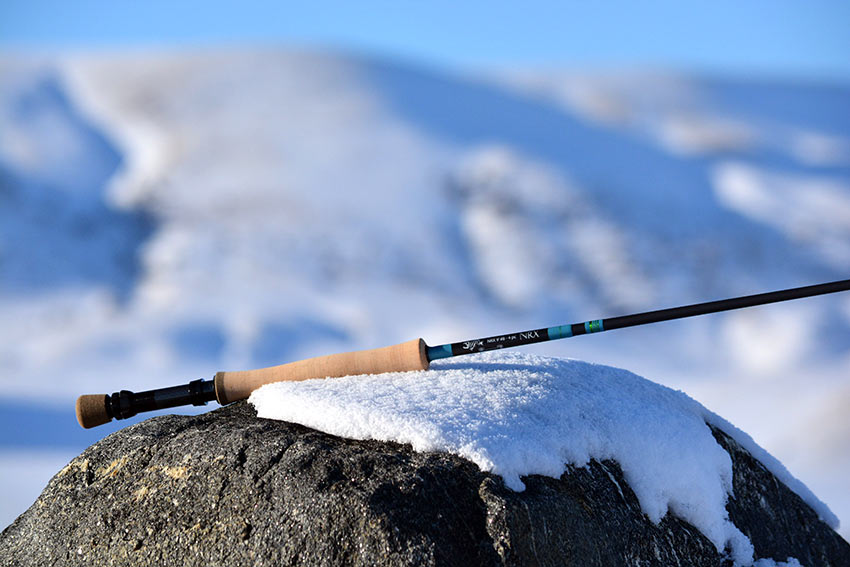

I guess it’s no surprise that the NRX would be near the top again this year since it won two of our last three 8-weight Shootouts! This is still one of the best casting rods I’ve used, and is especially impressive at mid to long range. I fish a lot of NRX rods throughout the year, in both fresh and saltwater, and I’m convinced that this is one of the very toughest rods on the market. I’ve had them doubled over playing trout up to 20 pounds, big permit and tarpon. They have performed without a whimper, when other rods have broken.
Part of this strength is the way Loomis has constructed these rods, and the way they have used the 3M nano-resins. Steve Rajeff, the head rod designer for Loomis, deserves a lot of credit for giving us rods that are both powerful but light in swing weight. His ability to design a progressive fast action, giving us softer tips than many other rods, is the key to why the NRX rods perform so well. When I’m casting the NRX, I’m always impressed with the way it tracks and forms such sweet tight loops.
If for any reason your NRX breaks, you call Loomis and use their Expeditor program. They charge your credit card $100 but then ship you a brand new rod in 2-3 days! They include a FedEx call tag so it costs you nothing to send the broken rod back.
This is a good looking rod, with a flat gray finish and robin’s egg blue wraps that include some green trim on the butt. The cork handle is a modified full wells, a Rajeff design similar to that on the Asquith. It is slightly larger ahead of the swell than at the back. Steve claims this gives you more control and power at longer distances. And he should know with all his fly-casting distance and accuracy championships won over the years.
A stack of thin cork rings is used as on the Asquith, to produce the best quality grip we’ve seen. The reel seat is their uplocking version found on other NRX rods but with an extra, easy to grip locking ring that allows a very positive lock up with the heavier saltwater reels. A short fighting butt is used. Two black wire recoil stripping guides are used, followed up with the best flexible nickel/titanium snake guides in a black pearl color. You are never going to break any of these guides! Like all Loomis rods, this is made in Woodland, Washington.
George’s casting notes:
Performance at 35 feet: 19 points out of 20
I notice the heavier swing weight than the Asquith. Both the Meridian and Orvis Helios 3F give me better feel and accuracy.
Performance at 60 feet: 19.5 points out of 20
Tracks beautifully, with good accuracy but can’t touch the Asquith. The Helios 3F and Meridian were also marginally better.
Performance at 80 feet: 20 points out of 20
I felt the NRX was as good as the Asquith at 80 feet, and was able to throw long tight loops with ease. As good as it gets.
Performance at 100 feet: 19.5 points out of 20
Only the Asquith was better, and the NRX was definitely better than the Meridian and Helios at extreme long range.
#4. Orvis Helios 3F 9 foot #8 $898.00
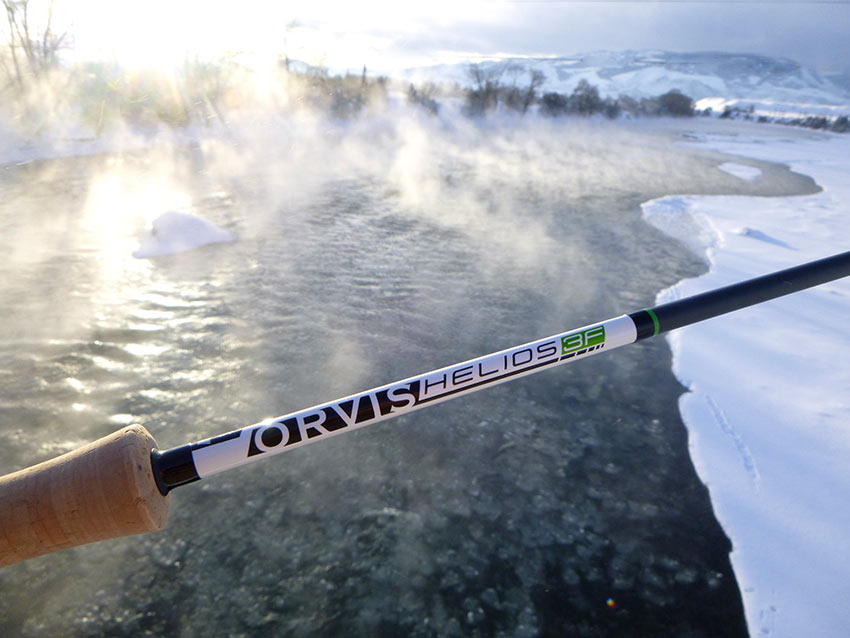

We were all impressed with how Orvis has improved the way this rod performs compared to the Helios 2. Once again a Helios was the lightest rod in swing weight, but now there are three other rods that match it – the Asquith, Meridian, and Exocett.
There is no question that this is a marvelous rod at short to medium distances where it took perfect scores. I loved the feel it gave me, combined with terrific accuracy. A lot of credit for this goes to the softer tip Orvis uses on this model. We tried the Helios 3D but decided that the 3F was the better rod based on how much better it was at short and mid-range distances. At long range the 3F still gets it done, but not with the authority of the Loomis Asquith or NRX. I thought that the Meridian and the Exocett were also better at 100 feet.
This is a fast action rod but with a very flexible tip that gives it such great feel and accuracy in close. In our performance scores, you’ll see that the 3F came in a close third, just behind the Meridian.
We’ve always been impressed with the Orvis craftsmanship and this rod is no exception. The only gripe I have is about the cosmetics. The six inches of white on the butt, above the cork grip is just plain UGLY. Nearly every person that has seen this rod has made the same comment. I guess the thinking at Orvis is that this would help the rod jump off the rack when people walked into a fly shop, but I think all this white is a mistake, especially for a company that has given us such great looking rods in the past. The blank color on the 3F is a flat gray with slightly darker gray wraps, which was all pretty bland to me, and certainly not nearly as attractive as blue Helios 2 rods. I do like the non-glare finish, similar to the NRX. The cork handle is a full wells, with the same kind of stack of thin, high quality cork found on the Loomis and Scott rods. The double ring, uplocking aluminum seat uses a flat gray graphite insert. Not pretty but very functional. I especially like the double wide first locking ring. You can really get a good grip on this wide ring. The extension butt is nice looking, with a contrasting darker composite cork on the bottom end.
The guides are excellent and similar to what Scott uses with two big titanium SiC strippers followed up with the excellent, flexible, nickel titanium snake guides. An oversize tip-top is used. This rod is built here in the USA at the Orvis plant in Manchester, VT.
George’s casting notes:
Performance at 35 feet: 20 points out of 20
With such great feel and accuracy it was hard to deny the 3F a prefect score. I felt the equally perfect Meridian had a tiny edge here.
Performance at 60 feet: 20 points out of 20
I loved the light swing weight and the beautifully controlled tight loops I was getting that produced superb accuracy.
Performance at 80 feet: 19.5 points out of 20
Surprisingly the 3F still did very well out long, matching the Meridian and Exocett! But the Asquith and NRX were definitely much better.
Performance at 100 feet: 18.7 points out of 20
Now the lack of power is showing itself. Both the Meridian and Exocett were giving me tighter loops and better accuracy.
#5. Thomas & Thomas Exocett 9 foot #8 $895.00
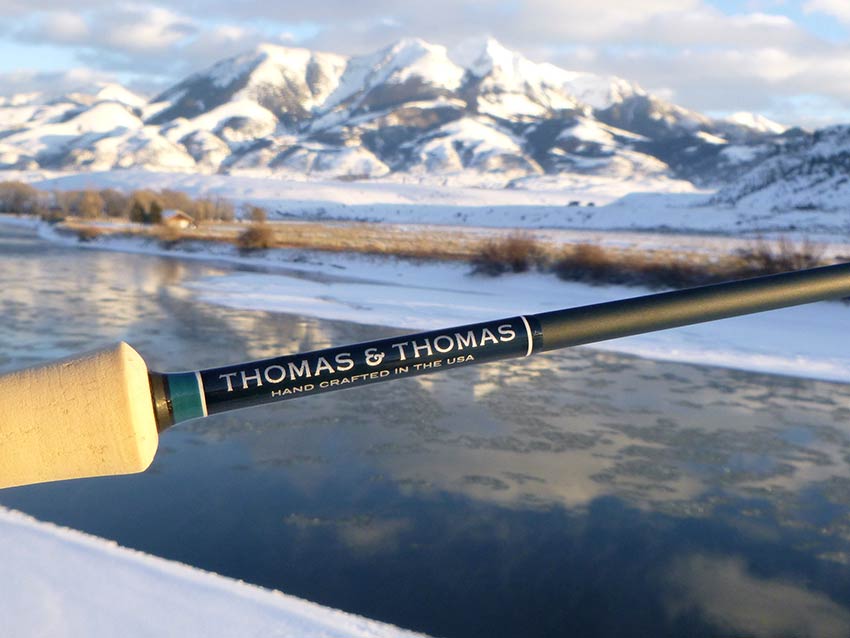

The Exocett is an impressive new rod from T&T. First, it’s a great looking rod with the same flawless craftsmanship that we have seen previously from T&T. We gave it a top score here along with the Asquith and Meridian. This is a fast action rod and as you can see on our deflection board, the flex pattern is similar to the Asquith, just a little softer and with not quite as fast a tip. It is also very light in hand, and tied the Asquith, Meridian and Helios 3F for the lowest swing weight. This is a rod that won’t wear you down after a hard day of fishing.
The Exocett is T&T’s best all around 8-weight, designed especially for saltwater anglers. It was a lot of fun to cast, and I could immediately notice the excellent damping, due, most likely in part, to T&T’s new Strato Therm Resin. The feel I was getting at short distance was good, but the accuracy was not quite as good as the Asquith, or the Meridian and Helios 3F. The sweet spots for the Exocett were the two middle distances, where it formed beautiful, tight loops. At 100 feet, it was still surprisingly good with lots of power to go long, and definitely better than the Orvis Helios 3F.
One thing that continues to amaze me is the level of perfection of T&T’s guide wraps and coatings. I’m sure the key is a multi step process rather than a one-coat finish. The blank itself is finished in a handsome matte dark blue color with lighter blue wraps, trimmed in white, resulting in a very elegant rod. Each section is numbered on the lower side, making it easy to line up all the pieces. The components are absolutely top shelf too. The cork handle uses the same kind of stack of thin cork rings that we see on the Loomis, Scott, and Orvis rods. T&T uses a pretty much standard full wells grip with a comfortable swell in the middle of the grip with flares at both ends. The light gray anodized double uplocking aluminum seat has two big locking rings that are very easy to grip and tighten. I wish more of the rods in our Shootout had rings as good as these! A short fighting butt with a contrasting cork ring at the bottom end is used. The two stripping guides are black colored titanium ceramic guides, a bit smaller than we found on the Orvis and Scott rods but slightly larger than on the Asquith. Black flexible nickel/titanium snake guides are used, with an oversize tip-top. This guide set-up is one of the best we’ve seen. The T&T rods are built at their plant in Greenfield, Massachusetts.
George’s casting notes:
Performance at 35 feet: 19 points out of 20
Good, but not quite the accuracy I was getting with the Meridian, Asquith, or 3F. I love the light swing weight.
Performance at 60 feet: 19.2 points out of 20
I couldn’t get the same tight loops and accuracy I was getting with the Asquith and Orvis 3F. Still a solid performance at this distance.
Performance at 80 feet: 19.5 points out of 20
Plenty of power to reach out and throw long. Felt as good to me as the Meridian and Helios 3F. The Asquith and NRX were noticeably better.
Performance at 100 feet: 19 points out of 20
Gets it done easily, with very good line control and tight loops. Better than the Helios 3F but not in the same class of either the Asquith or NRX.
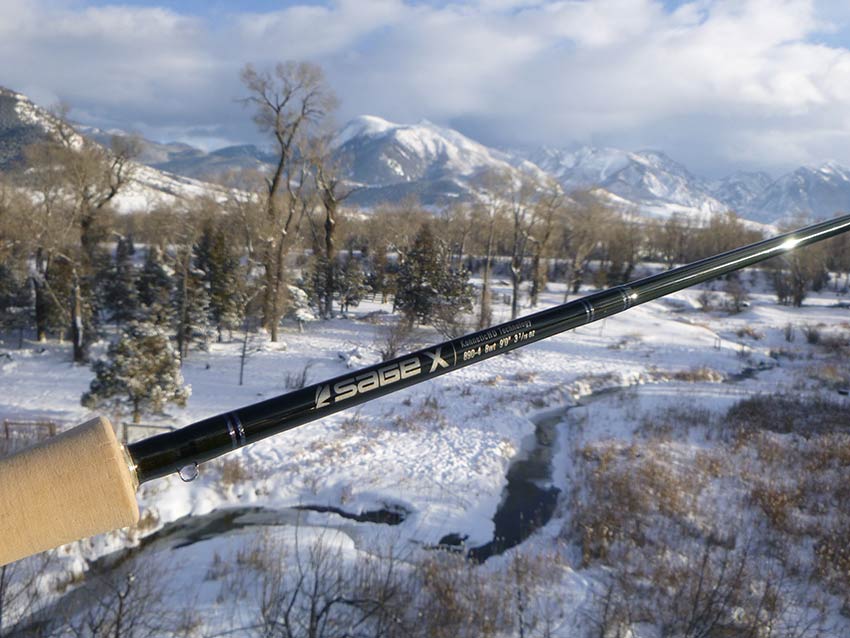

The more I cast these X rods, the more I like them. For one thing, they are very light rods and far, far lighter than Sage’s new Salt HD. The X was in a tie with the Recon and BVK for the lightest overall weight and only a half point from matching the winners in swing weight. It didn’t have quite the power of the new Salt HD, but the only distance where it faltered was at 100 feet. To me, the Sage X is a much more pleasant rod to cast and fish all day than the Salt HD.
This is a fast action rod, built with Sage’s latest KonneticHD technology. But a glance at our top rods deflection board will show you that the X has a much stiffer tip than the Orvis Helios 3F and even the Asquith, and this is the main reason it didn’t perform as well at 35 feet. At 60 and 80 feet though, it hung in there with the best rods. At these middle distances I found that I was getting very nice tight loops and good accuracy. Only at long range did the X seem to run out of gas.
The craftsmanship is the typical Sage excellence we have seen in the past. This is a bad ass looking rod, almost black at first glance, finished in deep dark green they call “Black Spruce.” Similar colored wraps are used that are trimmed with a little silver on the butt section.
The cork handle is Sage’s version of a full wells, with a smaller swell in the middle than found on most other full wells grips. I found it very comfortable. The black anodized double uplocking seat works well enough but the rings are smaller and much harder for me to grip than the ones on say the Asquith or Helios 3F. The rings on the Salt HD are bigger but still not that easy to grip. A heavier knurl would work wonders. I did like the line size designation on the sliding band of the reel seat. A comfortable, short fighting butt is used that has a good wide rubber end similar to what we found on the Salt HD. The guide set up is two hard chrome SiC strippers; the rest Sage’s traditional hard chrome snake guides. The snake guides and tip top are slightly smaller than we found on many of the 8-weight rods. I prefer the flexible nickel/titanium guides found on the five top rods in our Shootout. They won’t break and are a lot lighter than hard chrome snake guides, which helps reduce the swing weight. The Sage rods are built at their plant on Bainbridge Island, WA.
George’s casting notes:
Performance at 35 feet: 19 points out of 20
Pretty good feel and accuracy – far better than the Salt HD! The Asquith was noticeably better. A softer tip would help the X to match the Helios 3F and Meridian at short distance.
Performance at 60 feet: 19.4 points out of 20
A solid performance at mid-range. Good loop control with good accuracy. The NRX was slightly better.
Performance at 80 feet: 19.5 points out of 20
I was surprised at how well the X performed at 80 feet. Part of this was the ability to form nice tight loops. Equal to the Meridian, Helios 3F and Exocett here with only the Asquith and NRX better.
Performance at 100 feet: 18.5 points out of 20
At the longest distances the X lacks the power of the best rods. Here the Meridian and Exocett were noticeably better.
#7 Orvis Recon 9 foot #8 $450.00
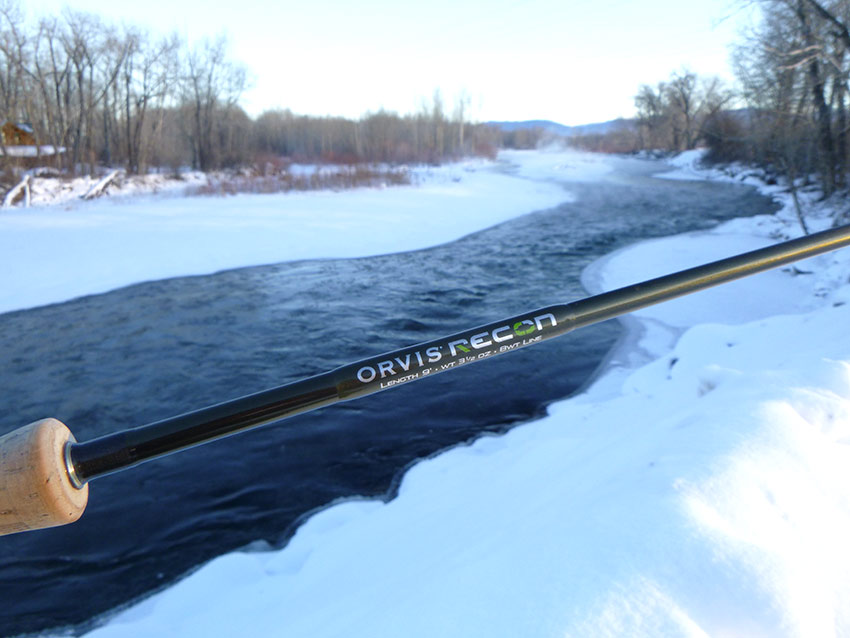

Here is the mid-price winner in our Shootout! We’ve always been impressed with the Recon as it combines light overall weight and swing weight with exceptional performance – and all at a very reasonable price! The fast action seems to be about perfect, with a softer tip than most of the other mid-priced rods. Even though very light, the Recon has plenty of power, except at the very longest distance. It tied the Sage X and BVK for the lightest overall weight, and the swing weight is extremely light too, only a half a point behind the winners. This makes for a very pleasant rod to fish hard all day long.
Sure, if you are an Orvis fan and can afford the new Helios 3F, it does provide a level of performance that’s a big step up from the Recon, both at short and long range. The Recon also uses lower grade components than the Helios 3F too, other than the cork handle, which is the same high quality stack of thin cork rings we found on the 3F. A full wells design is used.
The blank is what Orvis calls shadow green, (a dark olive green), with slightly darker brown wraps. The stripping guides are the more standard SiC guides than the titanium ones found on the 3F, and the snake guides are the cheaper hard chrome ones rather than the much more expensive nickel/titanium snake guides found on the Helios 3F. The brown anodized double uplocking reel seat is just OK. I found the rings, with their fine knurling, much harder to twist tight than the good ones we found on the Helios 3F. A short fighting butt is used with a rubber cap. The Recon is built at the Orvis factory in Manchester, VT.
George’s casting notes:
Performance at 35 feet: 19 points out of 20
Decent feel but the accuracy of the Helios 3F was far better. About equal to the Sage X and NRX at short range.
Performance at 60 feet: 19.5 points out of 20
Impressive – nice tight loops that delivered excellent accuracy. But the Helios 3D was significantly better.
Performance at 80 feet: 19 points out of 20
Plenty of power and good line control. The Sage X and Douglas Sky were slightly better here.
Performance at 100 feet: 18 points out of 20
I could not get the same kind of performance as the Helios 3F or the Sage X at extreme long range.
#8 Hardy Zephrus AWS 9 foot #8 $729.00
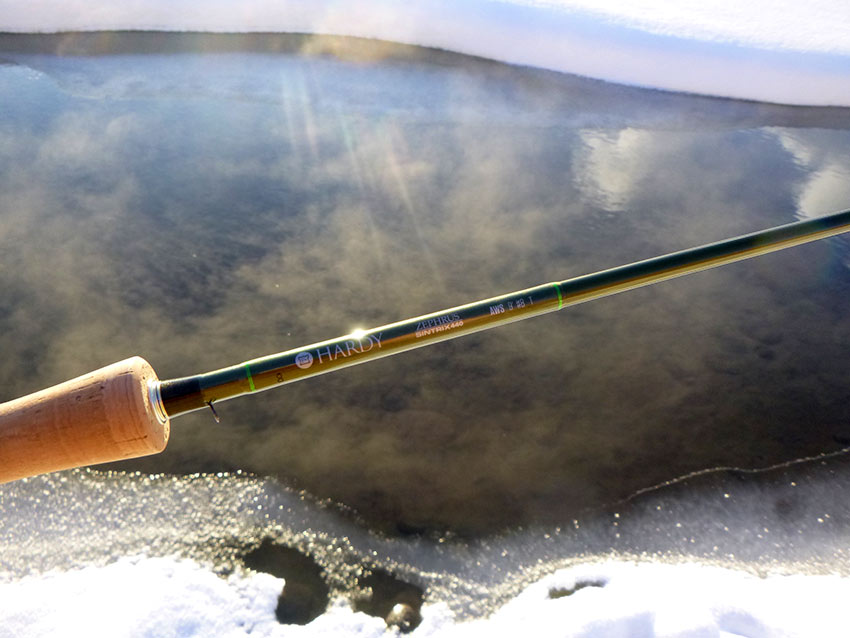

We tested the AWS model rather than the SWS. Both of these rods have a similar action and deflected in a similar manner, with the same amount of power. In the end we liked the AWS better as it was lighter and more pleasant to cast. This rod performed well across the board at all distances. It is perhaps not in the league with the best rods here but still a very solid performer. The Hardy rods are designed in England by Howard Croston, and manufactured in Korea.
The AWS is a fast action rod with a smooth action and excellent dampening. It’s light in overall weight and swing weight – coming in just behind the Sage X and Recon.
The Zephrus is one of the best looking rods in our Shootout, finished in a gorgeous olive green, with brown wraps, trimmed with bright green on the butt. The cork handle is a full wells design and felt just right. A double uplocking, anodized aluminum seat is used with a green triaxial carbon spacer that matches the blank color. The rings locked up well, but were a little harder to grip than on the best rods. I liked the two titanium SiC stripping guides, followed up with flexible nickel/titanium single foot guides the rest of the way. If anything, the single foot guides and tip top could be slightly larger, especially for saltwater use. My only gripe is the excessive amount of epoxy finish over the guide wraps.
George’s casting notes:
Performance at 35 feet: 19.2 points out of 20
I was getting good feel and pretty good accuracy but the top rods like the Asquith, Meridian and Helios 3F were noticeably better.
Performance at 60 feet: 19.5 points out of 20
Nice smooth action was producing good tight loops and very good accuracy. Slightly better than the Legend Elite and SKY at mid-range.
Performance at 80 feet: 19 points out of 20
Good, but not the kind of power I was getting with the Exocett or Meridian. And the Asquith was far better.
Performance at 100 feet: 19 points out of 20
Enough power to launch it long, with the same kind of performance I was getting with the Exocett and Meridian.
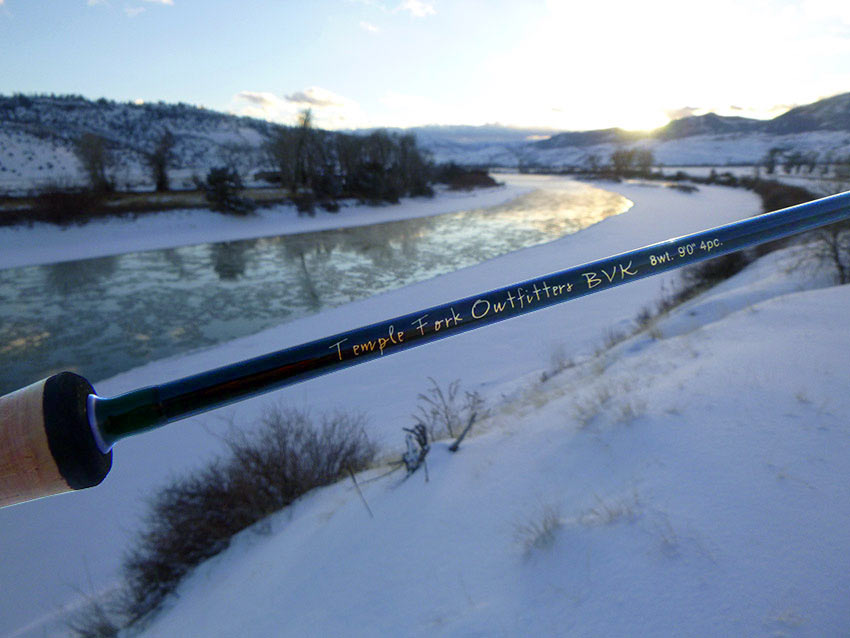

Since our very first 8-weight Shootouts, the BVK has really impressed me. When I get this rod in my hand, it’s nice and light, yet has an impressive amount of power. The fast action seems just right, and there is nothing in our Shootout that has this kind of performance at a price below $300.00. For this kind of money it is easy to overlook things like the tiny locking rings on the reel seat or the lack of a hard case.
We have TFO’s latest and more expensive rod, the Axiom II in our shootout, but I still prefer the power and action of the BVK. Another thing we like about the TFO rods is the warranty. We gave it a perfect score here since for $35 they will happily send you a replacement rod within 1-2 weeks. This is good since we have seen a lot of these rods break. I’ve taken BVK’s with me on many bonefish trips as a backup rod and have never had one break, even when I’ve put it in the hands of less experienced anglers and guides. Although the BVK was tied for the lightest rod in overall weight, the swing weight is far higher, and not in the same class of the best rods in our Shootout.
The blank is a deep olive green color, trimmed with slightly lighter green wraps. The handle is a full wells design with a rubber ring at the top. The quality of the cork is OK but not nearly as good as the best rods. An aluminum double uplocking seat, with a green graphite insert, is used but the rings are just too small and difficult to grip with their very fine knurling. Consider bringing along a pair of cheap vice grip pliers, as you may need them! A very short fighting butt with a rubber cap is used. Lefty Kreh helped design this rod and BVK are his initials. It’s a rod he can be proud of as it delivers big time performance with a very affordable price. This is another rod that is built in Korea.
George’s casting notes:
Performance at 35 feet: 19 points out of 20
Decent accuracy, but not nearly as much feel as the best rods. The heavier swing weight and stiffness hurts in close.
Performance at 60 feet: 19.5 points out of 20
Impressive at mid-range. I’m getting nice tight loops and very good accuracy.
Performance at 80 feet: 19 points out of 20
Good power and loop control out long. As good as the Recon, but the SKY and Legend Elite were better here.
Performance at 100 feet: 19 points out of 20
No problem punching it long and I’m getting surprisingly good accuracy too.
#10 Douglas SKY 9 foot #8 $695.00
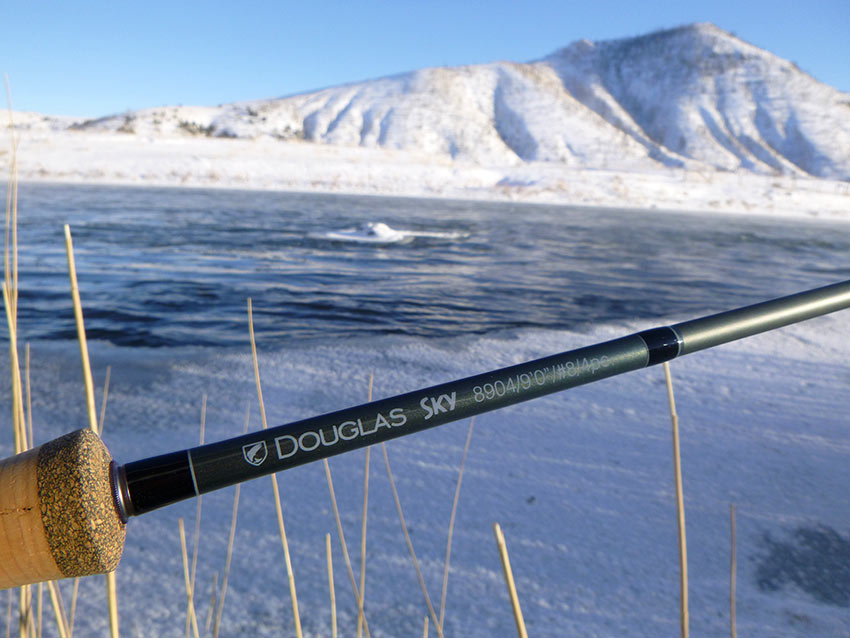

The Douglas SKY won our last 6-Weight Shootout, and here it puts in an impressive performance as an 8-weight. There are a lot of things to like about this rod – the appearance, the craftsmanship, the components, the performance, the warranty, and the price. I love the fast action that has very good butt and mid-section power, combined with a slightly softer tip. This produced an impressive performance at all distances. The SKY is designed here in the US by Fred Contaoi, but manufactured in Korea at the same plant that produces Hardy and Loop rods.
My only gripe is the swing weight, which like the BVK, is heavier than all the top rods. Like the other SKY rods, this is a good-looking rod. The blank is finished in a matte finish, non-glare grey with glossy black wraps. A comfortable full wells handle is used with contrasting composite cork rings at top and bottom. The grey anodized, double uplocking reel seat matches the color of the blank. I found the rings easy to grip and tighten, and an additional thin nylon ring at the top of each ring provided a secure lock up on the heavier saltwater reels. A fairly wide but short extension butt is used with composite cork on the end that matches what is used on the grip. Douglas is one of the only manufacturers using the new Fuji Torzite guides as stripping guides. They have a slightly forward angle that allows line to shoot more easily. The rest of the guides are the good flexible nickel/titanium one-foot guides with an oversize tiptop. This whole guide set-up works great, and allowed the line to shoot like crazy. I also love the rod sock that Douglas designed – one that will allow a rod that is put away wet to dry quickly.
The Douglas warranty rated one of the very best. For $35, broken sections are replaced and the turn around time is two weeks or less.
George’s casting notes:
Performance at 35 feet: 19 points out of 20
Good, but the heavier swing weight hurt the feel I was getting.
Performance at 60 feet: 19.2 points out of 20
I’m working harder than with the Meridian or NRX to get the same kind of accuracy.
Performance at 80 feet: 19.5 points out of 20
The SKY certainly has plenty of power and now it helps produce nice loops and good accuracy, matching the Helios 3F and even the Meridian.
Performance at 100 feet: 19 points out of 20
A strong performance here, with lots of power on tap. As good as the BVK and Exocett and slightly better than the Helios 3F.
#11 St. Croix Legend Elite SW 9 foot #8 $ 490.00
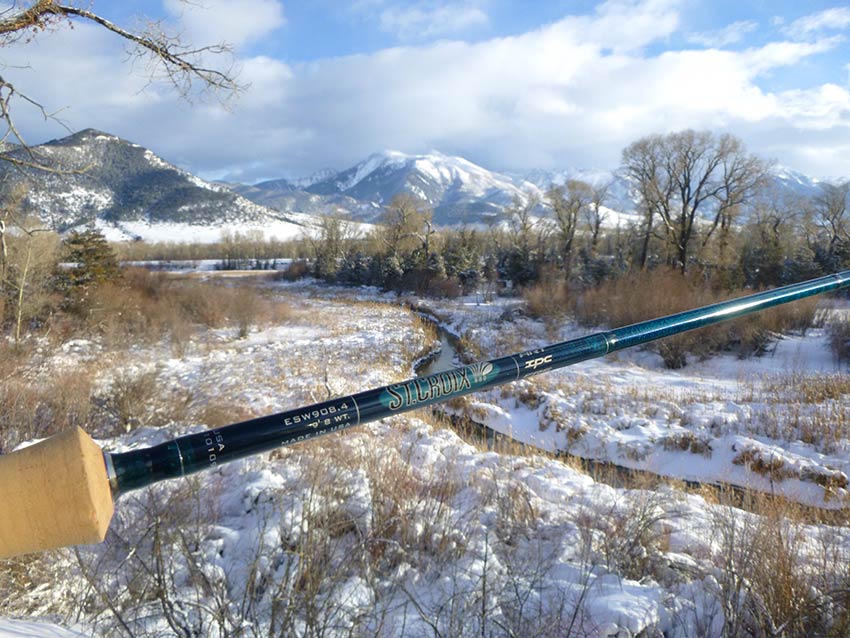

The saltwater version of the Legend Elite is a real bargain for the performance it provides. I felt it was just a shade behind the Orvis Recon for the title of best mid-priced 8-weight.
This is another fast action rod that has just the right amount of tip flex, with lots of power in the butt and mid sections. It put in a very good all around performance, and the only downside is its weight. It was heavier than all the best rods in both overall and swing weight. But this weight translates to good usable power, especially at the longer ranges. These have proven to be very tough rods too, with their own FRS nano-resin system.
The craftsmanship is some of the best we’ve seen. This is a great looking rod, the blank finished in a deep midnight blue with matching blue wraps. The handle is a full wells design with excellent quality cork. They use a gold anodized double uplocking seat with a nylon spacer at the top of each ring to help give a positive lock up. A short fighting butt with a rubber cap is used. Guides are two SiC stripping guides, with the rest large diameter hard chrome snake guides and an oversize tip top. This is another great rod made here in the US at Park Falls, Wisconsin.
George’s casting notes:
Performance at 35 feet: 19 points out of 20
Nice feel and good accuracy but I could definitely feel the heavier swing weight.
Performance at 60 feet: 19.2 points out of 20
Tracks well and I’m throwing nicely controlled loops. The Meridian and NRX were noticeably better.
Performance at 80 feet: 19.5 points out of 20
A little more effort needed, but I was getting impressive tight loops and good accuracy. Better than the Recon and BVK at long range.
Performance at 100 feet: 19 points out of 20
This rod has lots of power on tap but I’m working a lot harder than with the NRX or Asquith.
#12 (tie) Sage Motive 9 foot #8 $499.00
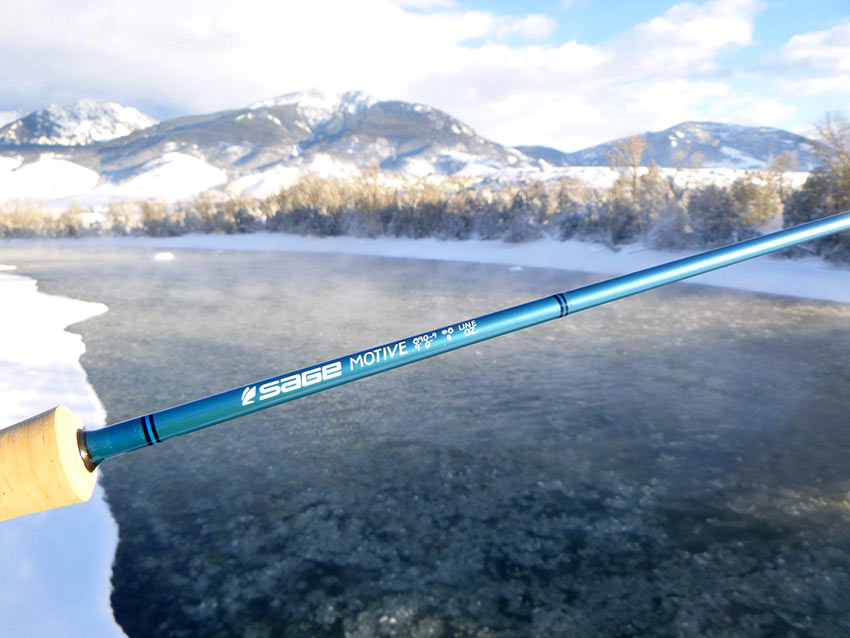

Here’s another rod that battled the Recon and Legend Elite for the title of best mid-priced rod. The Motive was in a tie for 4th in our last 8-weight Shootout, and still puts in a very solid performance here. I think the extra swing weight hurt, as the Motive is a lot heavier than the Sage X or the other top rods. Although about the same weight as the Salt HD, the Motive has a slightly faster action, and cast better for me at short to medium distances. Out long, the Salt HD had more beans. Performance-wise, the X was unquestionably better, especially at 35 and 60 feet. And it was far lighter in swing weight.
We all loved the snazzy, bright blue color of the Motive. The craftsmanship is typical Sage excellence. Guide wraps are a complementary blue with a little black trim on the butt section. A full wells grip is used with high quality standard cork rings. The reel seat is a black anodized double uplocking seat, but the locking rings are smaller and harder to grip than those found on the Salt HD. A short fighting butt with a large rubber cap is used that will be comfortable when you are cranking on big fish. The guides used are two SiC strippers, with the rest large hard chrome snake guides and an oversize tip top, similar to what we found on the Salt HD.
The Motive is built at the Sage factory on Bainbridge Island, Washington.
George’s casting notes:
Performance at 35 feet: 18.5 points out of 20
Just OK and not very much feel. The Recon was better and much lighter in hand.
Performance at 60 feet: 19 points out of 20
Mid range is the sweet spot for this rod. Forms nice loops but the X was more accurate and much more pleasant to cast.
Performance at 80 feet: 19 points out of 20
The Motive has both good power and good accuracy out long but I felt that both the X and the SKY were better.
Performance at 100 feet: 18.5 points out of 20
I could hit 100 feet, but not with the authority of the Salt HD or the NRX.
#12 (tie) Fenwick Aetos 9 foot #8 $189.95
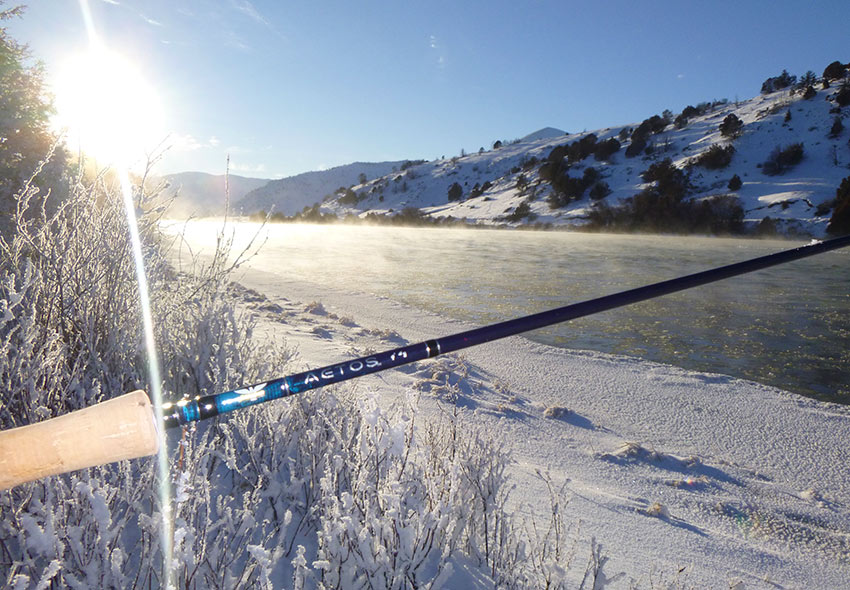

The Fenwick Aetos, at under two hundred bucks, is an incredible bargain! There is no question that this rod takes the title of Best Inexpensive Rod in our Shootout. Nothing else really comes close, especially when you factor in the kind of performance the Aetos delivers. It’s hard to gripe about the cheap components, especially for such a ridiculously low price. How did it score so well? The Aetos picked up a lot of points in the price and warranty categories and didn’t lose that many in the more important performance scores. The shocking thing to me is that the Aetos scored higher in our final results than seven rods over $300, including the Sage Salt HD at $950! Yes the BVK at $279.95 is marginally better, but you’ll have to spend another $30 to get a hard case. I liked the fast action and the relatively light overall weight and swing weight of the Aetos. It’s a pleasant rod to cast but it did lack the firepower of the best rods.
The Aetos is finished nicely in an attractive midnight dark blue with some silver trim on the butt section. The alignment marks are very well done and I don’t know why more manufacturers don’t use these. The guide wraps are dark brown and surprisingly the epoxy finish on the wraps is excellent. A full wells grip is used, but the quality of the cork is not so hot. A lot of filler is used on these pre-shaped grips, but what can you expect for such a low-ball price? The plain gray anodized double uplocking seat is nothing fancy either. The two locking rings are small and hard to grip. Keep a pair of pliers handy, as you may need them. A short fighting butt is used that looks too narrow to be as comfortable as the ones on the better rods. Fenwick uses two dark colored SiC stripping guides, followed up with fairly large size, black hard chrome snake guides. Like other Fenwick rods, this is built in Korea.
George’s casting notes:
Performance at 35 feet: 19 points out of 20
Feels very good in close – as good as the Recon. I was tempted to rate it higher.
Performance at 60 feet: 19 points out of 20
Shorter to medium distances are the sweet spot for the Aetos, where it forms nice controllable tight loops with good accuracy.
Performance at 80 feet: 18.5 points out of 20
Now the lack of power hurts. Not much for guts and this hurt the accuracy. The Recon was much better here.
Performance at 100 feet: 18 points out of 20
Not many casters will get even close to 100 feet with this rod, especially if there is any wind to contend with.
#14 (tie) Douglas DXF 9 foot #8 $395.00
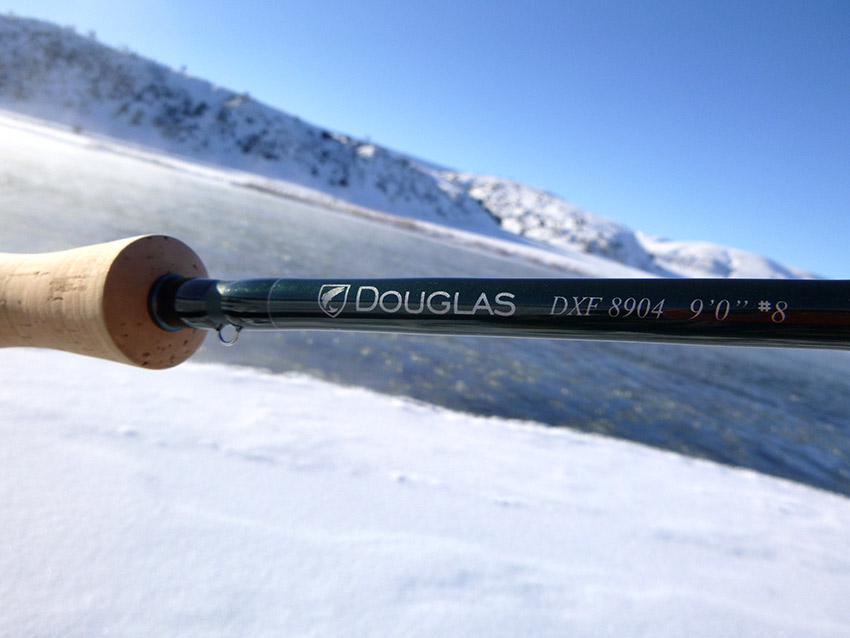

In our last 8-weight Shootout, the DXF didn’t perform so well and ended up next to last. This year the DXF is a much different rod, with far better performance. Douglas’ head rod designer, Fred Contaoi did a heck of a job reworking this rod and got the action just right. This is a fast action rod like the SKY, with the same slightly softer tip. The only thing that bothers me now is the heavy swing weight compared to the best rods here. This also hurt the feel somewhat, especially in close.
The Douglas rods have always been attractive, with excellent craftsmanship and this DXF is no exception. I especially like the grayish/green non-glare matte finish. The guide wraps are a complementary darker green with a glossy epoxy finish. The high quality cork handle is a full wells design and feels just right. A grayish/green anodized double uplocking reel seat is used, with the color complementing the blank perfectly. This is a classy looking rod. For uplocking rings, Douglas uses one wider ring, followed up with a narrower, but larger in diameter ring at the bottom that proved easy to grip. A nylon face on the final ring provides an excellent lock-up on heavier reels. A short fighting butt with a wide composite cork butt cap is used. Guides are not quite the quality we found on the SKY but still very good. They use two more standard SiC stripping guides followed by extra large size hard chrome snake guides and an oversize tip top. Line tangles are going to fly through these big guides! Last but not least is the great rod bag included with the aluminum tube that will help dry out a rod you might put away wet. The Douglas rods are designed here in the US but manufactured in Korea.
George’s casting notes:
Performance at 35 feet: 18.5 points out of 20
The heavy swing weight hurt both feel and accuracy in close. Both the BVK and Aetos felt better.
Performance at 60 feet: 19 points out of 20
Now I’m getting nice tight loops and good performance. The heavier swing weight is making me work harder than with the best rods.
Performance at 80 feet: 19 points out of 20
Smooth, easily controlled loops are giving me good accuracy. Both the SKY and Legend Elite were slightly better.
Performance at 100 feet: 18.5 points out of 20
At first I scored it a 19 since the accuracy was as good as the Exocett, but I was working a lot harder to make this distance.
#14 (tie) Hardy Shadow AWS 9 foot #8 $389.95
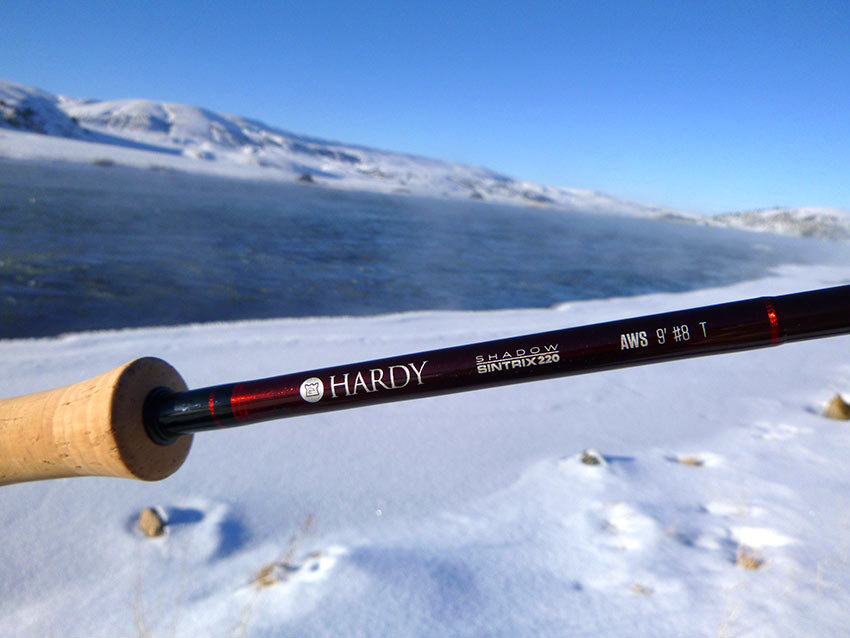

This is another new rod from Hardy with the same good looks and craftsmanship as we found in the Zephrus AWS, but at a much lower price. This rod has a slower action than the Zephrus, with a slightly stiffer tip. It’s nice and light in hand, but doesn’t have the same kind of power to deliver the goods at long range as does the Zephrus AWS. The Shadow was a pleasant rod to cast, and felt light in my hand, with both light overall and swing weights. The components are not quite up to the Zephrus’ standards, but in line with the lower price.
This rod is finished the color of a fine burgundy wine, with black wraps trimmed in red on the butt section. I think this is one of the better-looking rods in our Shootout. The cork grip is a full wells design, but slightly smaller in diameter through the swell than most. The quality of the cork itself was excellent. A black anodized double uplocking seat is used. A layer of nylon on the upside of the rings helped to provide a solid lock up on the reel. The fine knurling on the rings did made them harder to grip than the best rings we found on the Helios 3F or Scott Meridian. A short fighting butt of composite cork is used, but not as wide in diameter as on the best rods. For guides, Hardy uses two standard SiC stripping guides followed up with dark hard chrome one -foot guides, but these are not the good flexible ones we found on the Zephrus. The single-foot guides used on the Shadow were a little small too, especially for saltwater use. Like the Zephrus, this rod is designed in England but produced in Korea.
George’s casting notes:
Performance at 35 feet: 19 points out of 20
I was getting pretty good feel combined with good accuracy. The Zephrus was better in close.
Performance at 60 feet: 19 points out of 20
Nice smooth loops and decent accuracy, but The Zephrus, SKY and BVK were definitely better.
Performance at 80 feet: 18.5 points out of 20
The lack of guts now becomes apparent. The Zephrus was a lot better out long.
Performance at 100 feet: 18 points out of 20
I had trouble hitting 100 feet. The DXF and Motive were a lot better at extreme long range.
#16 (tie) Loop Q 9 foot #8 $229.00
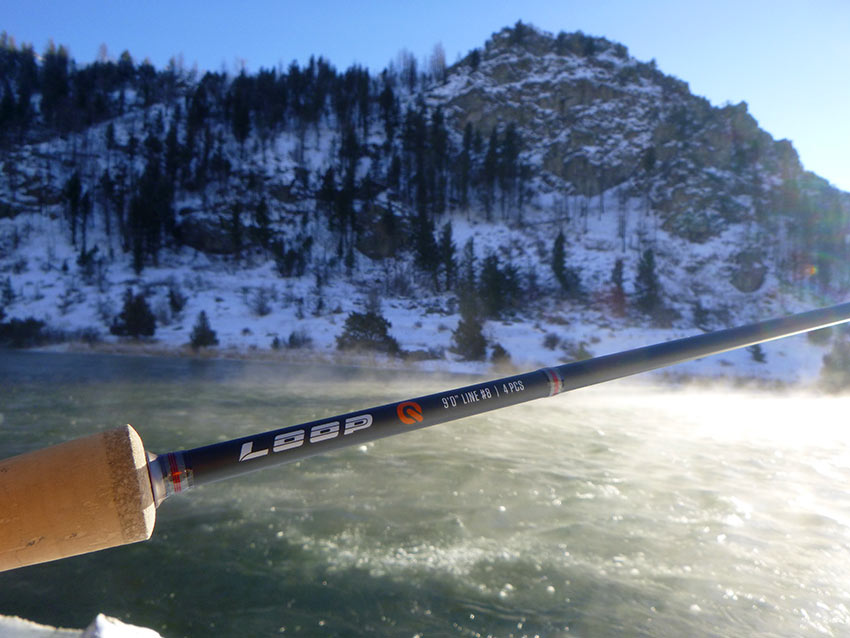

We were delighted with the performance of this new rod from Loop, considering its crazy low price. The Q is a medium fast action rod with a slightly softer tip than the Cross SW, and this helped give it more feel and accuracy in close. But at longer distances the Cross SW and the better rods blew it away.
The Q is a good-looking rod, with much better components than we expected to see in this price range. Another thing that impressed me was its extremely light swing weight that matched some of the best rods. This will be a very pleasant rod to cast and fish all day.
The blank itself is finished in a medium matte gray, with lighter gray wraps trimmed in red on the butt section. Loop uses a full wells cork handle with contrasting cork rings at top and bottom. The cork handle had more filler than I’d like to see – the quality of cork used was not nearly as good as on the Cross SX. Its matte gray anodized double uplocking seat matches the color of the blank. The rings were fairly large and pretty easy to grip. The bottom ring has a thin nylon insert on the top, which helped give a positive lock up with a heavier reel. A short fighting butt is used that has a wide composite cork on the end for comfort while fighting fish. The guide set up is only one SiC stripping guide, followed up with large size hard chrome snake guides and an oversize tiptop. This rod is designed by Loop in Sweden, but produced in Korea.
George’s casting notes:
Performance at 35 feet: 19 points out of 20
The softer tip gave me pretty good feel and even better accuracy than with the Cross SW. Shorter distances are the sweet spot for this rod.
Performance at 60 feet: 18.5 points out of 20
Decent, but not nearly as good as the Cross SW or the DXF.
Performance at 80 feet: 18.5 points out of 20
The lack of stiffness hurt at long range. As good as the Aetos, but both the BVK and SKY were much better.
Performance at 100 feet: 18 points out of 20
The lack of guts and butt section power compared to the Cross SW made it difficult for me to hit the 100-foot mark.
#16 (tie) Scott Tidal 9 foot #8 $495.00
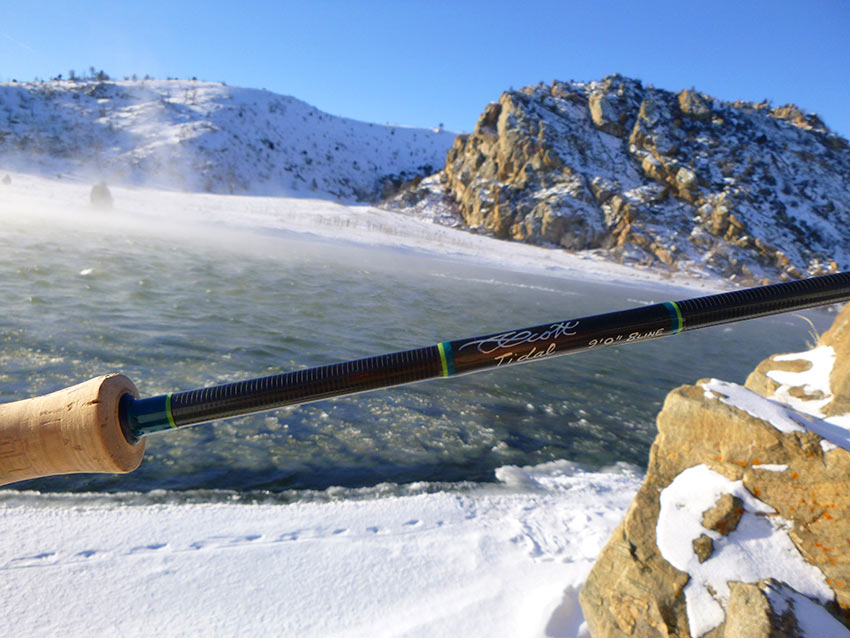

After seeing what a marvelous performance the Scott Meridian turned in, the Tidal was somewhat of a disappointment. I think the main reason for its lack of performance is a much slower action and heavier swing weight than the Meridian. The Tidal has more of a medium action compared to the fast action Meridian, and it just didn’t have that same crisp feel in my hand, nor the power of the Meridian. I’m sure a lot of this has to do with the lower modulus graphite used in the Tidal. But I keep feeling that a faster action would have made a big difference.
There are a lot of things to like about the Tidal, such as the superb craftsmanship we’ve come to expect from Scott. The components are downgraded somewhat from the Meridian, but that is to be expected with a rod that costs $400 less.
Like the Meridian, the blank is natural graphite gray, and in keeping with Scott tradition, only lightly sanded so you can still see the tape marks. The wraps are a medium blue, trimmed in green on the butt. Alignment dots are used on all sections. Scott does use the same great cork handle we see on the Meridian – a full wells design with a stack of thin, very high quality cork rings. A flat black anodized double uplocking seat is used, but the rings were not nearly as easy to grip as the ones found on the Meridian. A short fighting butt is used with a rubber cap. The guides start out with two large SiC stripping guides, followed up with fairly large hard chrome snake guides and an oversize tip top. The wraps and coatings on the guides are close to perfect. Like the Meridian, the Tidal is manufactured by Scott in Montrose, Colorado.
George’s casting notes:
Performance at 35 feet: 18.5 points out of 20
Feels heavy in the tip and I’m struggling to get any decent accuracy. The Meridian was FAR better in close.
Performance at 60 feet: 19 points out of 20
Mid-range seems to be the sweet spot for this rod, and I was getting nicely controlled loops with good accuracy. But both the BVK and Recon were noticeably better.
Performance at 80 feet: 18.5 points out of 20
Nowhere near the pop and zing I was getting with the Meridian. Both the Recon and DXF were better.
Performance at 100 feet: 18.5 points out of 20
If there was little wind I could hit the mark, but not with any consistency. More butt section power would help. The Meridian and even the BVK were much better.
#16 (tie) Loop Cross SW (Fast) 9 foot #8 $849.00
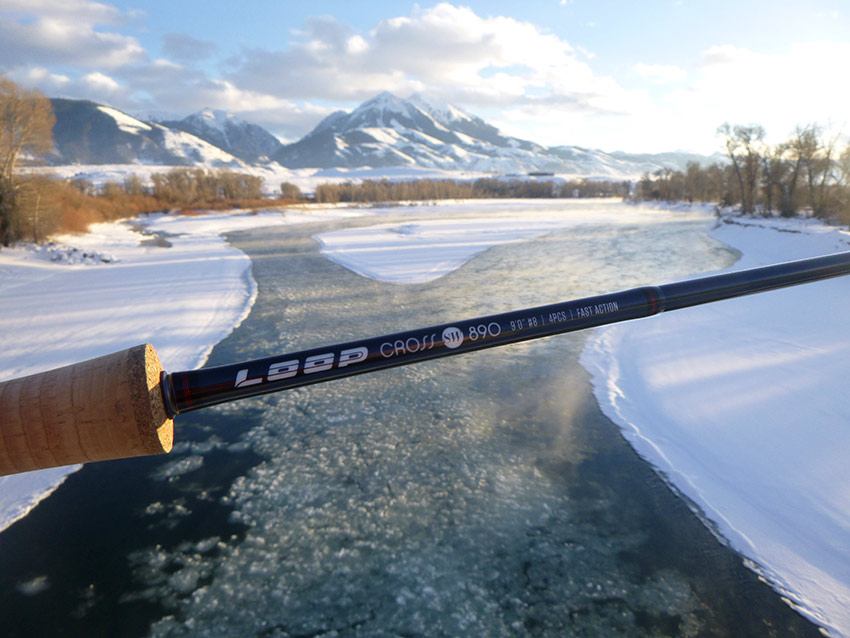

I had high expectations for the Cross SW when I first flexed it in my hand, and I’m still surprised to see how far down the Shootout it finished. This is a fast action rod with plenty of power. This is a stiff rod, and this hurt its performance at close range. It was also one of the heavier rods in both overall and swing weights, so it lost a lot of points here, and it was more tiring to cast than much lighter rods like the Asquith, Meridian, Helios 3F and Exocett. Despite its heavier weight, it did perform very well at medium to longer distances, here matching many of the best rods.
The craftsmanship is top shelf. This is a very attractive rod, finished in a dark midnight blue, with black wraps that include a little red on the butt section. The epoxy coatings on the wraps were very well done. I also like the use of alignment dots on each section. Loop uses a full wells handle with contrasting corks at top and bottom and a fairly large swell in the middle of the grip. The reel seat is a gray anodized, double uplocking affair, but a very unusual design. Rather than an insert, they use three round aluminum legs that allow you to see the actual blank in the middle of the seat. The locking rings are larger than most, with a nylon insert on the bottom ring that provided a very secure lock-up on the reel. The large diameter cap of composite cork on the fighting butt looks comfortable, and matches the cork on the handle.
The top-notch guide set up utilizes two large titanium SiC stripping guides and then excellent flexible nickel/titanium snake guides, in a large size and dark color. An oversize tip- top is used. Like the Loop Q, this rod is designed in Sweden and manufactured in Korea.
George’s casting notes:
Performance at 35 feet: 18.5 points out of 20
The stiffness and heavy swing weight hurt both the feel and accuracy in close. All the top rods were better here.
Performance at 60 feet: 19.5 points out of 20
With more line in the air I’m getting nice tight loops with excellent accuracy. But the rod still feels heavy in hand. The Asquith and Meridian threw even tighter loops and were much more pleasant to cast.
Performance at 80 feet: 19.5 points out of 20
Tracks well, with lots of power on tap. This is a great rod at mid to long range. Only the Asquith and NRX were better.
Performance at 100 feet: 19 points out of 20
Carries a lot of line in the air easily, and gave me good accuracy. As good as the Meridian and Exocett, with only the Asquith and NRX better.
#19. Sage Salt HD 9 foot #8 $950.00
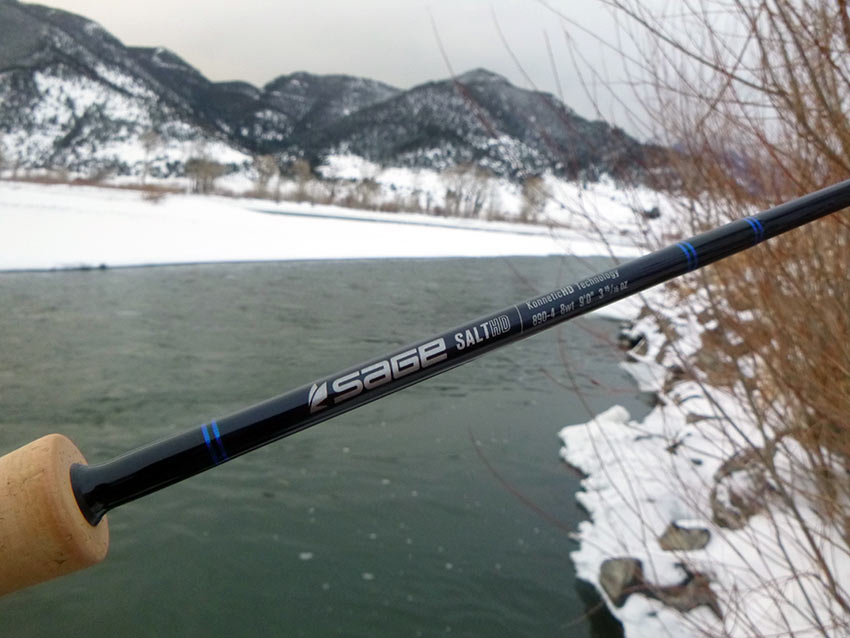

In our last 8-weight Shootout the Sage Salt didn’t fare too well. We were excited to see how the new Salt HD compared, especially with all the good press it has gotten. Well, I have to tell you that we are still disappointed with the new Salt HD. Some of the same problems we found in the original Salt still plague the HD. Namely, it is heavy, especially in the all important swing weight category, and the tip is still too stiff. If you are a Sage Fan, we are confident that you’ll like the X much better. The X has a much faster action and softer tip, giving it a whole lot more feel combined with tighter loops and better accuracy than the Salt HD at short to medium distances. Even though the HD is stiffer than the X, I didn’t feel it cast better until I was trying to hit 100 feet.
Craftsmanship was the same excellence we have come to expect from Sage. The rod itself is an extremely dark blue called “Squid Ink,” with some blue trim wraps on the butt. The cork handle is Sage’s full wells design that does not have as pronounced a swell in the middle as most. To me, it felt very comfortable. The cork itself is that same stack of small width, very high quality cork rings that many of the best rods are using now.
The matte finished black anodized double uplocking seat is one of the best we’ve seen. The line size designation is marked on the top of the sliding band; a nice touch. If you have multiple rods in the rod rack in say, a skiff, you can tell at a glance that this is the 8-weight. The locking rings are much larger that the ones on the X, and very easy to grip and tighten. Sage uses a nylon face on the front of bottom ring, which allows a very secure lock up on the reel. A short fighting butt is used with a wide rubber end that will be comfortable fighting fish. The guide set up is two SiC stripping guides similar to what we found on the X, followed up with large size hard chrome snake guides and an oversize tip top. The snake guides are larger than we found on the X, which is good, but they are also heavier, and this hurts the swing weight. For a rod that costs $950 Sage should be using the best Recoil nickel/titanium snake guides similar to the flexible and far lighter guides that Loomis and Scott use. These make a dramatic difference in reducing swing weight on the tip sections of a rod.
The Salt HD is manufactured at the Sage plant on Bainbridge Island, WA.
George’s casting notes:
Performance at 35 feet: 18 points out of 20
All that weight combined with a stiff tip provided very little feel and poor accuracy compared to the X. The Meridian and Helios 3F were FAR better.
Performance at 60 feet: 18.5 points out of 20
Good, not great. Both the X and the NRX were a lot better. I wasn’t getting good tight loops as I did with the X.
Performance at 80 feet: 19 points out of 20
With more line in the air, the performance is better. Surprisingly, the X gave me tighter loops and was more accurate at long range.
Performance at 100 feet: 19 points out of 20
Only at extreme long range did the HD feel like the best rods. But both the NRX and Asquith blew it away.
#20. TFO Axiom II 9 foot #8 $339.95
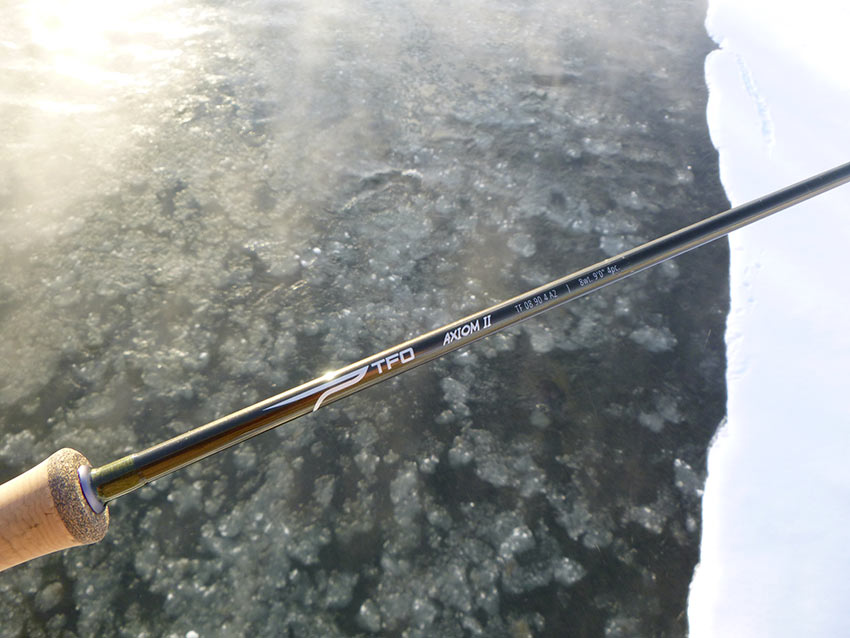

Here is TFO’s latest offering that is supposed to be a big step up from the BVK. I didn’t think it was nearly as good overall, and certainly didn’t have the power of the BVK that we have liked so much. It does have a softer tip than the BVK so its performance in close was slightly better. The Axiom II is slightly softer overall than the BVK, and does not have nearly as much punch and power to throw long. This seems strange to me since the Axiom II is both heavier in overall weight and swing weight than the BVK. One big improvement over the BVK are the locking rings on the reel seat. And for the extra $60 they also now give you a hard case like all the other manufacturers.
The color of the blank is a dark olive, with complementary olive wraps. Like the BVK, alignment dots are used. The cork handle is a full wells design, and the quality of the cork is excellent – better than the BVK. A contrasting composite cork ring is used at the top of the grip. The reel seat is a gray anodized double uplock, but with much larger locking rings than found on the BVK. The bottom ring also has a nylon spacer attached that helps to maintain a positive lock up on your reel. A green graphite spacer is used with a handy yellow line showing where to insert the reel seat. A short composite cork, fighting butt is used. The guides are two large SiC strippers, followed with hard chrome snake guides. Like other TFO rods, the Axiom II is manufactured in Korea.
George’s casting notes:
Performance at 35 feet: 19.2 points out of 20
The softer tip gave me better feel and accuracy than the BVK. As good as the Zephrus and even better than the Recon.
Performance at 60 feet: 18.5 points out of 20
Doesn’t fire the line with the authority of the BVK, and my loops were not as tight. Both the Motive and Recon were also better here.
Performance at 80 feet: 18 points out of 20
Not so hot at the longest distances. Doesn’t seem to have enough power to carry the same tight loops as the BVK or Motive.
Performance at 100 feet: 17 points out of 20
I didn’t feel this rod has enough power to hit the longest distance with any consistency. The BVK was far better.
#21 (tie) Beulah Opal 9 foot #8 $620.00
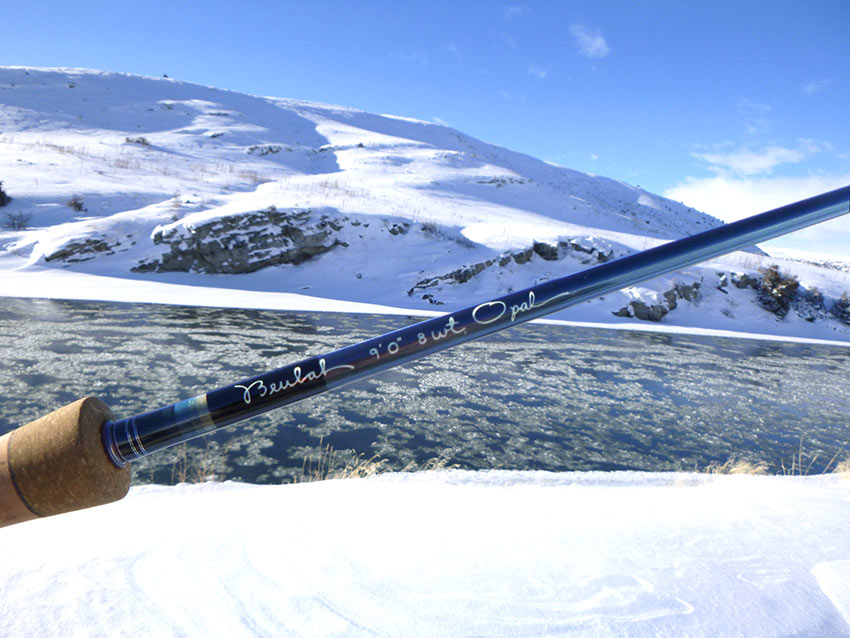

Beulah has impressed us with great looking rods and very good craftsmanship and their Opal is another good example. Unfortunately the performance just wasn’t up to the level of the better rods. I think one thing that hurt is that the Opal is one of the heaviest rods in our Shootout. It just didn’t have the punch and power of other rods like the BVK or any of the other good mid-priced rods like the Recon and Motive. This rod has a more moderate than fast action. It is a smooth casting rod, but not as accurate as I wished.
The thing that first caught my eye is this rod’s snazzy appearance, and especially the fancy cork grip. The blank color is pleasing blue/gray with complementary wraps. The butt has some darker blue wraps trimmed in silver. All very tasteful. Beulah is famous for their fancy cork handles. This one is a full wells design, but with a variety of beautiful contrasting cork rings top and bottom. A gray anodized double uplocking seat is used that matches the color of the blank. The rings are quite large in diameter and easy to grip. The lower ring utilizes a nylon insert that allows a very positive lock up on the reel. The short fighting butt has another good, wide contrasting cork on the end. This rod is designed here in the US by Beulah but manufactured in Korea.
George’s casting notes:
Performance at 35 feet: 18.5 points out of 20
Good, just not great. Smooth enough, but not as accurate as the Recon or SKY.
Performance at 60 feet: 18.5 points out of 20
The weight in hand is heavier than I like. I’m not able to get the same tight loops or accuracy I’m getting with the Recon or BVK.
Performance at 80 feet: 19 points out of 20
Nice and smooth here and tracks well. Matches the Recon, but not in the same class as the best rods.
Performance at 100 feet: 18 points out of 20
It was tough for me to hit the longest distance. More power would help here.
#21 (tie) Redington CRUX 9 foot #8 $399.95
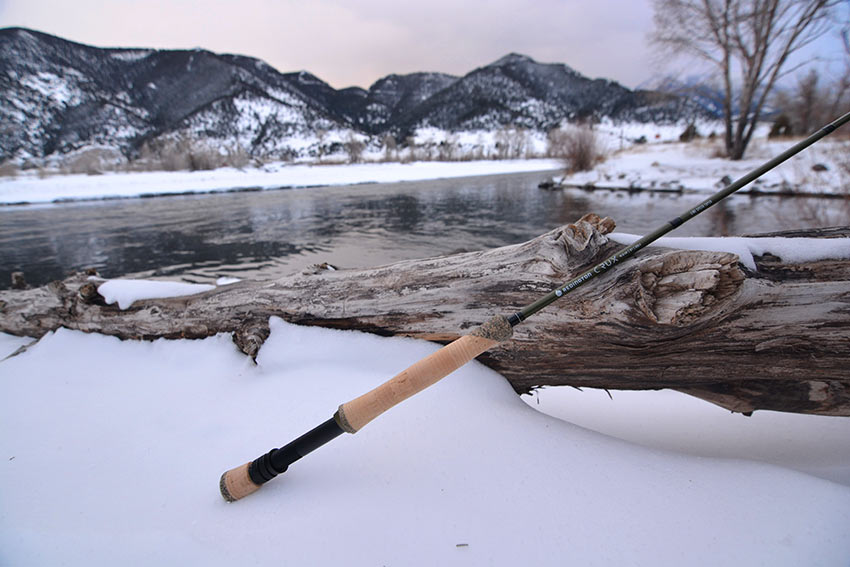

We have two Redington rods in this Shootout, with the CRUX being perhaps the best one, but at $200.00 more than the VICE. Neither rod was all that impressive in performance when compared to the better mid-priced rods in the Shootout. $400 puts the Crux in that mid-price category, but when comparing it heads up to the Orvis Recon, the difference was like night and day! The Recon is far lighter and has a much faster action, which allowed it to cast dramatically better at all distances. The Crux has more of a medium action, with a stiffer tip, and it’s HEAVY! It is one of the heaviest rods we tested in swing weight. The slower action combined with all that weight made for a dismal performance.
Despite the lackluster performance, the Crux is a handsome rod, with good craftsmanship. The thing that grabs you is the unusual handle design and the use of angled composite cork along with the standard cork rings. The idea is to increase durability, where your thumb rests. This is a full wells design with a smaller swell than most. The quality of cork is excellent. The rod itself has a pleasing metallic olive matte finish, with dark brown wraps and olive trim on the butt section. The quality of the epoxy coatings over the wraps is good. They use a black anodized double uplocking seat but the knurling on the rings is too fine, making them very hard to grip. At least the bottom ring has a nylon face that allows it to lock up well once you do get it tight. On the front side of the reel seat is an anodized olive hood that gives the line size combined with built in hook keepers on both sides. A short fighting butt is used with a composite cork on the end, matching what is found on the handle. Rod guides are two SiC stripping guides followed with hard chrome snake guides with an oversized tiptop. This rod is manufactured in Korea.
George’s casting notes:
Performance at 35 feet: 18.5 points out of 20
The heavy swing weight and stiffness in the tip hurt a lot in close. Both the Recon and Aetos were much better.
Performance at 60 feet: 18.5 points out of 20
Decent balance and loop control, but the Recon and BVK were dramatically better.
Performance at 80 feet: 18 points out of 20
All that swing weight is becoming tiring, and I’m working hard to hit the 80-foot mark.
Performance at 100 feet: 17 points out of 20
Not enough power to get it done. The Vice was much better at the longest distances.
#23. Redington VICE 9 foot #8 $199.95
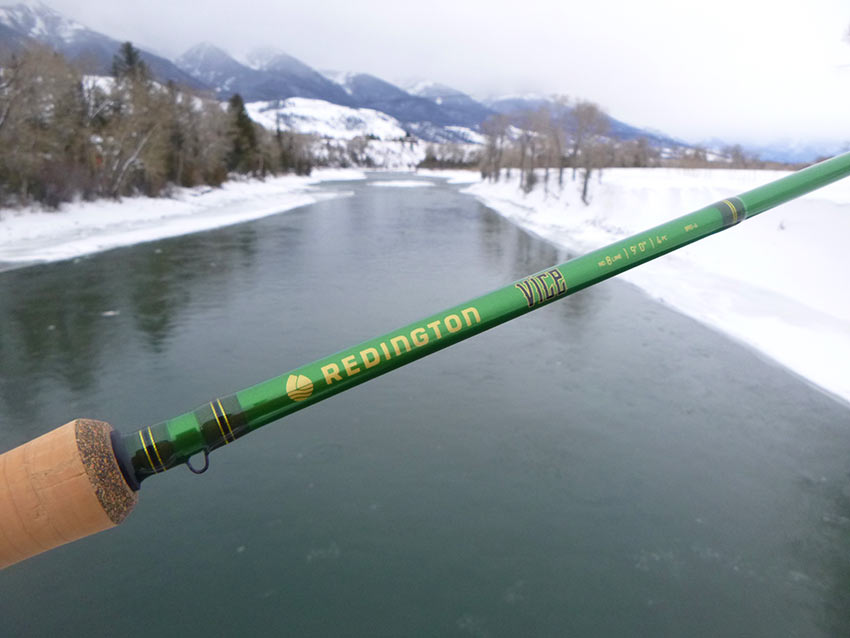

Wow, that bright green blank jumps right out at you! Here is another attractive rod from Redington. I just wish the performance matched the good looks – it doesn’t. This is medium fast action rod, faster than the Crux and with a lot more power in the butt and midsections. But the price for having more power is an even heavier swing weight! Only the Mystic Inception was heavier. So if you plan to fish this rod hard all day, better get into the gym and beef up those forearms.
In that $200 class, I had hoped it would compare well with the Fenwick Aetos, but it isn’t even close. The Aetos was FAR lighter in hand, and scored much better at all but the longest distance. At the shorter distances, the VICE had so little feel I had no confidence in where I was placing the fly.
The bright metallic green blank has dark brown wraps, trimmed with some gold on the butt section. The handle is a full wells, but one with very little swell in the middle – somewhat like the handle design on the Sage rods. I felt that the diameter was a little small too, which might cramp your hand, having to deal with the heavy swing weight. The quality of cork is not nearly as good as on the CRUX and a lot of filler was present. The reel seat was pretty cheap too. It is a black anodized uplocking seat, but with only one locking ring! No way is this seat going to hold a heavier saltwater reel for very long. Bring your pliers as you are going to need them. A short fighting butt is used with a fairly wide composite cork ring on the end. The guides are two SiC strippers, but smaller than what we found on the Crux. The rest are large size, black colored, hard chrome snake guides with an oversized tiptop. Like on the Crux, the epoxy coating on the guide wraps was good. Like other Redington rods, the VICE is manufactured in Korea.
George’s casting notes:
Performance at 35 feet: 17 points out of 20
With all that swing weight and stiffness in the tip, I was getting almost no feel. The accuracy was terrible too – only the Inception was worse.
Performance at 60 feet: 18 points out of 20
Respectable, but I’m working a lot harder than with the Aetos or DXF.
Performance at 80 feet: 18.5 points out of 20
Finally the power in this rod is allowing me to throw some nice loops with decent accuracy.
Performance at 100 feet: 19 points out of 20
Now all that power redeems itself with the ability to form long tight loops. The longest casts were possible, but proved to be a real workout.
#24. Mystic Reaper 9 foot #8 $279.00
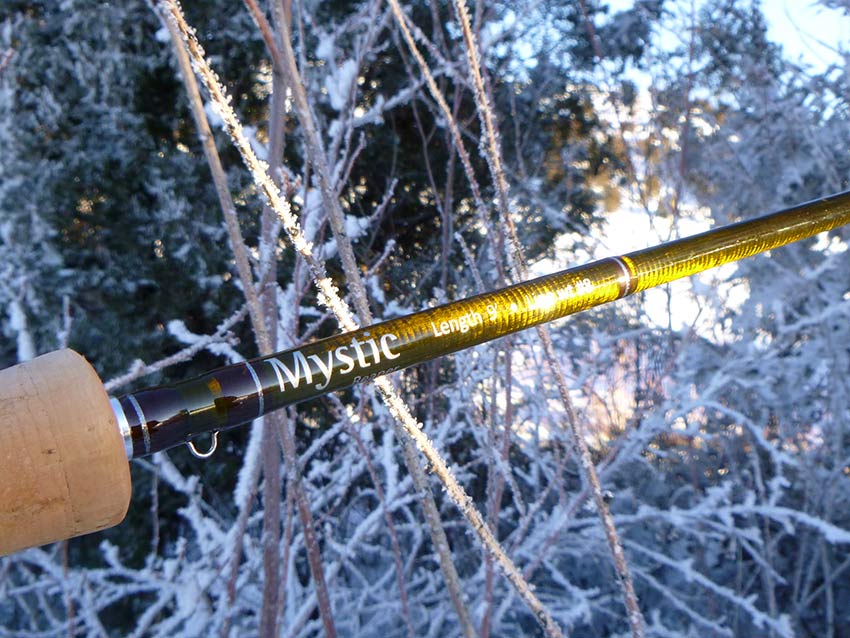

I’ve liked the Mystic Reaper in our 5-weight Shootouts, but as an 8-weight it just doesn’t have the guts and power it needs to compete with the better inexpensive rods. The medium fast action is about right. All it really needs is more power in the butt sections. As is, the lack of overall power limits the Reaper’s ability to chuck it long, like I was able to with the similar priced TFO BVK.
The Reaper is finished in a pleasing medium brown color, with slightly darker brown wraps. A little silver trim is found on the butt section. The epoxy coatings over the wraps and on the butt are excellent. A comfortable full wells grip is used but the quality of the cork is just OK, about as good as what we found on the BVK and Aetos. A silver anodized double uplocking reel seat is used, but the rings were harder to grip than most. A heavier knurl on the rings would help. They do use a nylon washer on the bottom ring that allows a good lock up on the reel. A short fighting butt is used with a fairly wide composite cork end. The guide set up starts out with two Fuji SiC strippers, followed up with good large diameter hard chrome snake guides. The tiptop is smaller than we would like to see, especially when combined with the larger diameter snake guides. This is another rod that is manufactured in Korea.
George’s casting notes:
Performance at 35 feet: 19 points out of 20
I was getting good feel and accuracy in close with the softer tip on this rod. Surprisingly, as good as the Recon in close.
Performance at 60 feet: 18.5 points out of 20
Nice and smooth, but I couldn’t match the accuracy I was getting with other inexpensive rods like the BVK or Aetos.
Performance at 80 feet: 18 points out of 20
Now the lack of power hurts and I’m struggling to hit 80 feet. With any wind it became impossible.
Performance at 100 feet: 16 points out of 20
Not going to happen for all but the very best casters.
#25. Mystic Inception 9 foot #8 $120.00
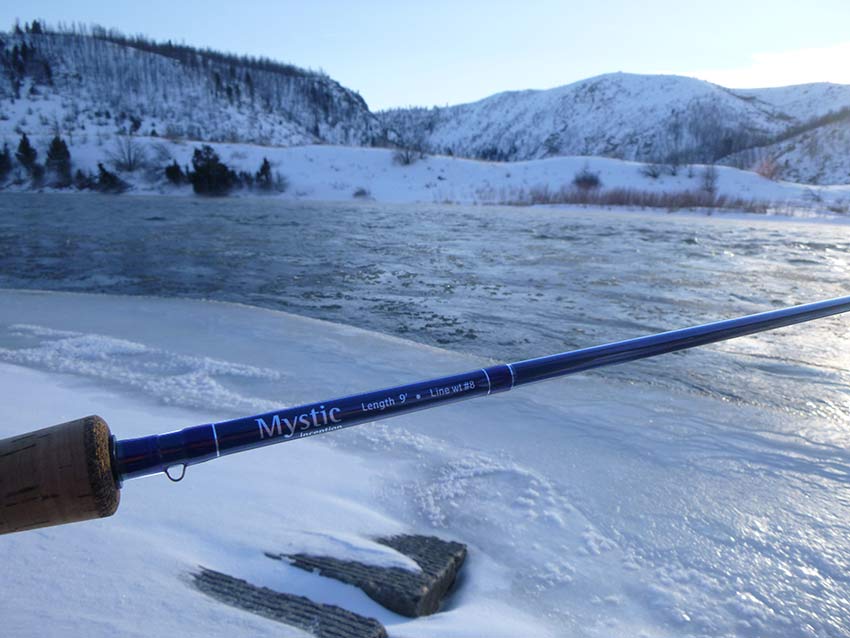

Here’s our low price winner in the Shootout. Unfortunately that was the only category it did well in. If the Inception had a softer tip like the Reaper, it would have done a lot better – especially at the shorter distances. This rod has a medium action and was the heaviest rod in our Shootout, in both overall and swing weights. This killed the performance in close. Compared to lighter and more lively rods, the Inception is not a pleasant rod to cast at any distance.
The blank is dark blue, trimmed with brighter blue wraps that are trimmed with silver on both butt sections. The handle is a comfortable full wells design, with contrasting composite cork rings at top and bottom. The cork quality was decent, and better than what we found on the Reaper. A blue anodized double uplock seat is used that matches the blank color. The locking rings were a little easier for me to grip than what was on the Reaper, and a nylon ring is found between the two rings that helps give a positive lock up on heavier saltwater reels. A short fighting butt is used with a good wide composite cork ring on the end. The guide set up is two SiC stripping guides, followed with large size hard chrome snake guides and a big oversized tip top. As on the Reaper, the guide wrap epoxy coatings were very good. Like other Mystic rods, this rod is manufactured in Korea.
George’s casting notes:
Performance at 35 feet: 16 points out of 20
The worst in our Shootout. Heavy swing weight combined with a stiff tip never works well.
Performance at 60 feet: 17.5 points out of 20
Still pretty bad. I had trouble getting any accuracy at all and had almost no feel whatsoever.
Performance at 80 feet: 18 points out of 20
All that swing weight made me work hard. Only as good as the Crux and Axiom II.
Performance at 100 feet: 17 points out of 20
Could be done, but required a huge amount of effort.
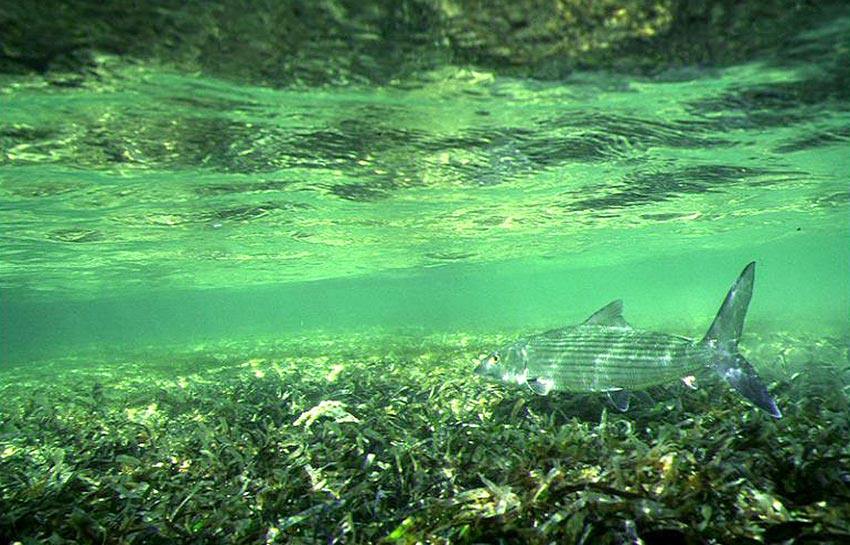
Thoughts About a Purchase
If you are thinking about buying a fly rod, we suggest reading one of our Shootouts for the line size rod you want. You’ll find these on our Yellowstone Angler website home page. If your local shop stocks the rods you are interested in, by all means visit them, try a few rods and purchase an outfit from them.
If you cannot find or cast the rods that interest you, we are here to help. Call us at 406-222-7130, and we will discuss your needs and wants. If you happen to be looking for an 8-weight, we hope that this Shootout has been informative. With our combined input, I’m confident that we can come up with the perfect rod or outfit that best fits your needs. Normally if you are getting both the rod and reel, we’ll throw in an $85 line for free, and also ship it to you for free as well. And since we are in Montana, there is no sales tax.
When you get the rod, do some casting on the lawn, and if you feel it is not just what you want, and it has not been fished and looks 100% new, we’ll allow you to return it to us for a full refund, less the shipping charges.
These Shootouts take a lot of time and effort, so if you like what we are doing the best way to thank us is to buy a rod, reel, or outfit from the Yellowstone Angler. Use this link to go to our Favorite Fly Rod Outfits. Here you’ll find our recommendations in three price ranges: Best Buy, Mid-Priced, and the Ultimate Outfit.
If you get to Montana, we invite you to stop at our shop and do your own mini-Shootout right on our lawn. We have several reels rigged up with the various line sizes, and leaders, all ready to go. We’ll come out with you and give you some help to fine tune your casting stroke, or just help you with the basics. And once you’ve picked out the perfect rod, stay and enjoy a few days on the water with one of our top guides.
We value your comments about the shootout and invite any questions you might have about it or your tackle needs. We have fished all over the world in both fresh and saltwater for a variety of fish, and we’ll be glad to help answer any questions you might have.
– George, James, and the rest of the Yellowstone Angler crew